- Undergraduate
- High School
- Architecture
- American History
- Asian History
- Antique Literature
- American Literature
- Asian Literature
- Classic English Literature
- World Literature
- Creative Writing
- Linguistics
- Criminal Justice
- Legal Issues
- Anthropology
- Archaeology
- Political Science
- World Affairs
- African-American Studies
- East European Studies
- Latin-American Studies
- Native-American Studies
- West European Studies
- Family and Consumer Science
- Social Issues
- Women and Gender Studies
- Social Work
- Natural Sciences
- Pharmacology
- Earth science
- Agriculture
- Agricultural Studies
- Computer Science
- IT Management
- Mathematics
- Investments
- Engineering and Technology
- Engineering
- Aeronautics
- Medicine and Health
- Alternative Medicine
- Communications and Media
- Advertising
- Communication Strategies
- Public Relations
- Educational Theories
- Teacher's Career
- Chicago/Turabian
- Company Analysis
- Education Theories
- Shakespeare
- Canadian Studies
- Food Safety
- Relation of Global Warming and Extreme Weather Condition
- Movie Review
- Admission Essay
- Annotated Bibliography
- Application Essay
- Article Critique
Article Review
- Article Writing
- Book Review
- Business Plan
- Business Proposal
- Capstone Project
- Cover Letter
- Creative Essay
- Dissertation
- Dissertation - Abstract
- Dissertation - Conclusion
- Dissertation - Discussion
- Dissertation - Hypothesis
- Dissertation - Introduction
- Dissertation - Literature
- Dissertation - Methodology
- Dissertation - Results
- GCSE Coursework
- Grant Proposal
- Marketing Plan
- Multiple Choice Quiz
- Personal Statement
- Power Point Presentation
- Power Point Presentation With Speaker Notes
- Questionnaire
- Reaction Paper
- Research Paper
- Research Proposal
- SWOT analysis
- Thesis Paper
- Online Quiz
- Literature Review
- Movie Analysis
- Statistics problem
- Math Problem
- All papers examples
- How It Works
- Money Back Policy
- Terms of Use
- Privacy Policy
- We Are Hiring

Motivational Theories, Essay Example
Pages: 2
Words: 595
Hire a Writer for Custom Essay
Use 10% Off Discount: "custom10" in 1 Click 👇
You are free to use it as an inspiration or a source for your own work.
Part of a manager’s duties in the workplace involves motivating employees. A manager who successfully motivates his or her employees will be able to reap the benefits tied to better employee performance. A manager who unsuccessfully motivates employees earns the consequences of a poorly functioning organization. Managers can apply different motivational theories to assist them in motivating staff. Three motivational theories, Expectancy Theory, Reinforcement Theory, and Adam’s Equity Theory of Motivation, are useful tools for motivating employees.
Expectancy Theory points to the relationship between motivation and outcome (“Expectency Theory” n.d.). Essentially, the theory states that people will work hard when they expect the outcome of their hard work to be positive (“Expectency Theory” n.d.). As such, expectancy theory states that motivating people should come down to three things (“Expectency Theory” n.d.). First, motivation is a factor of effort (“Expectency Theory” n.d.). In order to motivate others, employers should encourage the belief that more effort equals better performance. Second, employers should encourage the belief that better performance will lead to better rewards (“Expectency Theory” n.d.).Finally, employers should focus on the outcome by making sure that the reward is attractive to the employee (“Expectency Theory” n.d.).
Expectancy theory has both pros and cons when managers use it in the application of performance improvement. First, since expectancy theory is dependent upon individual perspective, the outcome is dependent on each employee’s individual perspective. If the manager has an understanding of the perspective, it will be successful; otherwise it will fail miserably. If managers want to see the results of expectancy theory, they can utilize several tools. First they can use a reward system that is closely tied to pay-for-performance (“Expectency Theory” n.d.). Second, they can use training to instill the belief that added effort will lead to better performance.
A second motivational theory, Reinforcement Theory, states that individuals behaviors are a function of the consequences (“Reinforcement Theory” n.d.). In other words, an individual will repeat behaviors that lead to positive consequences and fail to repeat behaviors that lead to negative consequences (“Reinforcement Theory” n.d.). Management should be sure to tie the consequence directly to the behavior in order to see the results.
While Reinforcement Theory can be helpful to managers, it has been criticized for failing to focus on the causes of individuals’ behavior. On the positive side, the theory can be a strong tool for analyzing the controlling mechanisms of human behavior (“Reinforcement Theory” n.d.). Under this theory, managers can use several tools to motivate individuals’ behavior including positive reinforcement or negative reinforcement (“Reinforcement Theory” n.d.).
The third motivational theory is Adam’s Equity Theory of Motivation. This theory states that employees will strive to achieve equity between them and their coworkers (buzz). This can be achieved when the outcome to input ratio is equal for all employees (buzz). Managers can implement this theory by tying rewards to performance and by setting goals effectively for workers (buzz).
Adam’s Equity Theory can work in situations where the work employees perform is easy to measure and compare. When employees perform similar, standardized procedures, managers can easily compare the data. However, sometimes employees perform job duties that may not tie directly to a quantifiable measure. In cases such as this, equity theory falls short.
Motivated employees will work harder. This hard work leads to a more profitable company. Motivation theories explain ways managers can ensure that their organizations are more profitable. With proper application, both employees and managers can reap the benefits.
Expectency Theory: Motivate Your Team by Linking Effort With Outcome. (n.d.) Retrieved from http://www.lacpa.org.lb/Includes/Images/Docs/TC/TC341.pdf
Reinforcement Theory of Motivation. (n.d.). Retreived from http://www.managementstudyguide.com/reinforcement-theory-motivation.htm
Equity Theory of Motivation. (n.d.) Retreived from http://www.buzzle.com/articles/equity-theory-of-motivation.html
Stuck with your Essay?
Get in touch with one of our experts for instant help!
A Wishing Well Premise, Article Review Example
A Brief History of Soap, Essay Example
Time is precious
don’t waste it!
Plagiarism-free guarantee
Privacy guarantee
Secure checkout
Money back guarantee

Related Essay Samples & Examples
Voting as a civic responsibility, essay example.
Pages: 1
Words: 287
Utilitarianism and Its Applications, Essay Example
Words: 356
The Age-Related Changes of the Older Person, Essay Example
Words: 448
The Problems ESOL Teachers Face, Essay Example
Pages: 8
Words: 2293
Should English Be the Primary Language? Essay Example
Pages: 4
Words: 999
The Term “Social Construction of Reality”, Essay Example
Words: 371
Motivation: Introduction to the Theory, Concepts, and Research
- First Online: 03 May 2018
Cite this chapter

- Paulina Arango 4
Part of the book series: Literacy Studies ((LITS,volume 15))
1599 Accesses
2 Citations
Motivation is a psychological construct that refers to the disposition to act and direct behavior according to a goal. Like most of psychological processes, motivation develops throughout the life span and is influenced by both biological and environmental factors. The aim of this chapter is to summarize research on the development of motivation from infancy to adolescence, which can help understand the typical developmental trajectories of this ability and its relation to learning. We will start with a review of some of the most influential theories of motivation and the aspects each of them has emphasized. We will also explore how biology and experience interact in this development, paying special attention to factors such as: school, family, and peers, as well as characteristics of the child including self-esteem, cognitive development, and temperament. Finally, we will discuss the implications of understanding the developmental trajectories and the factors that have an impact on this development, for both teachers and parents.
- Achievement
- Motivational theories
- Influences on motivation
This is a preview of subscription content, log in via an institution to check access.
Access this chapter
- Available as PDF
- Read on any device
- Instant download
- Own it forever
- Available as EPUB and PDF
- Compact, lightweight edition
- Dispatched in 3 to 5 business days
- Free shipping worldwide - see info
- Durable hardcover edition
Tax calculation will be finalised at checkout
Purchases are for personal use only
Institutional subscriptions
This is not intended to be an exhaustive review of motivational theories. For a more detailed review see: (Dörnyei and Ushioda 2013 ; Eccles and Wigfield 2002 ; Wentzel and Miele 2009 ; Wigfield et al. 2007 ).
For more information on the development of motivation in adults you can see: Carstensen 1993 ; Kanfer and Ackerman 2004 ; Wlodkowski 2011 .
Atkinson, J. W. (1957). Motivational determinants of risk taking behavior. Psychological Review, 64 (6), 359–372. https://doi.org/10.1037/h0043445 .
Article Google Scholar
Atkinson, J. W., & Raynor, J. O. (1978). Personality, motivation, and achievement . Oxford: Hemisphere.
Google Scholar
Aunola, K., Leskinen, E., Onatsu-Arvilommi, T., & Nurmi, J. E. (2002). Three methods for studying developmental change: A case of reading skills and self-concept. British Journal of Educational Psychology, 72 (3), 343–364. https://doi.org/10.1348/000709902320634447 .
Bandura, A. (1986). Social foundations of thought and action: A social cognitive theory . Englewood Cliffs: Prentice-Hall.
Bandura, A. (1991). Self-regulation of motivation through anticipatory and self-reactive mechanisms. In R. A. Dienstbier (Ed.), Perspectives on motivation: Nebraska symposium on motivation (Vol. 38, pp. 69–164). Lincoln: University of Nebraska Press.
Bandura, A. (1997). Self-efficacy: The exercise of control . New York: Freeman.
Bandura, A. (1999). A social cognitive theory of personality. In L. Pervin & O. John (Eds.), Handbook of personality (2nd ed., pp. 154–196). New York: Guilford.
Bandura, A., Barbaranelli, C., Caprara, G. V., & Pastorelli, C. (2001). Self-efficacy beliefs as shapers of children’s aspirations and career trajectories. Child Development, 72 (1), 187–206. https://doi.org/10.1111/1467-8624.00273 .
Bechara, A., Damasio, H., & Damasio, A. R. (2000). Emotion, decision making and the orbitofrontal cortex. Cerebral Cortex, 10 (3), 295–307. https://doi.org/10.1093/cercor/10.3.295 .
Boulton, M. J., Don, J., & Boulton, L. (2011). Predicting children’s liking of school from their peer relationships. Social Psychology of Education, 14 (4), 489–501. https://doi.org/10.1007/s11218-011-9156-0 .
Bradley, R. H., & Corwyn, R. F. (2002). Socioeconomic status and child development. Annual Review of Psychology, 53 (1), 371–399. https://doi.org/10.1146/annurev.psych.53.100901.135233 .
Brechwald, W. A., & Prinstein, M. J. (2011). Beyond homophily: A decade of advances in understanding peer influence processes. Journal of Research on Adolescence, 21 (1), 166–179. https://doi.org/10.1111/j.1532-7795.2010.00721.x .
Buss, D. M. (2008). Human nature and individual differences. In S. E. Hampson & H. S. Friedman (Eds.), The handbook of personality: Theory and research (pp. 29–60). New York: The Guilford Press.
Cain, K. M., & Dweck, C. S. (1989). The development of children’s conceptions of Intelligence; A theoretical framework. In R. J. Sternberg (Ed.), Advances in the psychology of human intelligence (Vol. 5, pp. 47–82). Hillsdale: Erlbaum.
Cain, K., & Dweck, C. S. (1995). The relation between motivational patterns and achievement cognitions through the elementary school years. Merrill-Palmer Quarterly, 41 (1), 25–52.
Carlson, C. L., Mann, M., & Alexander, D. K. (2000). Effects of reward and response cost on the performance and motivation of children with ADHD. Cognitive Therapy and Research, 24 (1), 87–98. https://doi.org/10.1023/A:1005455009154 .
Carstensen, L. L. (1993, January). Motivation for social contact across the life span: A theory of socioemotional selectivity. In Nebraska symposium on motivation (Vol. 40, pp. 209–254).
Catalano, R. F., Berglund, M. L., Ryan, J. A., Lonczak, H. S., & Hawkins, J. D. (2004). Positive youth development in the United States: Research findings on evaluations of positive youth development programs. The Annals of the American Academy of Political and Social Science, 591 (1), 98–124. https://doi.org/10.1177/0002716203260102 .
Coll, C. G., Bearer, E. L., & Lerner, R. M. (2014). Nature and nurture: The complex interplay of genetic and environmental influences on human behavior and development . Mahwah: Psychology Press.
Collins, W. A., Maccoby, E. E., Steinberg, L., Hetherington, E. M., & Bornstein, M. H. (2000). Contemporary research on parenting: The case for nature and nurture. American Psychologist, 55 (2), 218–232. https://doi.org/10.1037/0003–066X.55.2.218 .
Conger, R. D., Wallace, L. E., Sun, Y., Simons, R. L., McLoyd, V. C., & Brody, G. H. (2002). Economic pressure in African American families: A replication and extension of the family stress model. Developmental Psychology, 38 (2), 179. https://doi.org/10.1037/0012–1649.38.2.179 .
Connell, J. P. (1985). A new multidimensional measure of children’s perception of control. Child Development, 56 (4), 1018–1041. https://doi.org/10.2307/1130113 .
Damasio, A. R., Everitt, B. J., & Bishop, D. (1996). The somatic marker hypothesis and the possible functions of the prefrontal cortex [and discussion]. Philosophical Transactions of the Royal Society of London B: Biological Sciences, 351 (1346), 1413–1420. https://doi.org/10.1098/rstb.1996.0125 .
Deci, E. L., & Ryan, R. M. (2000). The “what” and “why” of goal pursuits: Human needs and the self–determination of behavior. Psychological Inquiry, 11 (4), 227–268. https://doi.org/10.1207/S15327965PLI1104_01 .
Deci, E. L., & Ryan, R. M. (2002a). The paradox of achievement: The harder you push, the worse it gets. In J. Aronson (Ed.), Improving academic achievement: Impact of psychological factors on education (pp. 61–87). San Diego: Academic Press.
Chapter Google Scholar
Deci, E. L., & Ryan, R. M. (2002b). Self–determination research: Reflections and future directions. In E. L. Deci & R. M. Ryan (Eds.), Handbook of self–determination theory research (pp. 431–441). Rochester: University of Rochester Press.
Dörnyei, Z., & Ushioda, E. (2013). Teaching and researching: Motivation . London: Routledge. https://doi.org/10.4324/9781315833750 .
Book Google Scholar
Dweck, C. S. (2002). The development of ability conceptions. In A. Wigfield & J. S. Eccles (Eds.), Development of achievement motivation (pp. 57–88). San Diego: Academic Press. https://doi.org/10.1016/B978–012750053–9/50005–X .
Eccles, J. S. (1987). Gender roles and women’s achievement–related decisions. Psychology of Women Quarterly, 11 (2), 135–172. https://doi.org/10.1111/j.1471–6402.1987.tb00781.x .
Eccles, J. S. (1993). School and family effects on the ontogeny of children’s interests, self–perceptions, and activity choice. In J. Jacobs (Ed.), Nebraska symposium on motivation, 1992: Developmental perspectives on motivation (pp. 145–208). Lincoln: University of Nebraska Press.
Eccles, J. S., & Harold, R. D. (1993). Parent–school involvement during the early adolescent years. Teachers’ College Record, 94 , 568–587.
Eccles, J. S., & Wigfield, A. (1995). In the mind of the actor: The structure of adolescents’ achievement task values and expectancy–related beliefs. Personality and Social Psychology Bulletin, 21 (3), 215–225. https://doi.org/10.1177/0146167295213003 .
Eccles, J. S., & Wigfield, A. (2002). Motivational beliefs, values, and goals. Annual Review of Psychology, 53 (1), 109–132. https://doi.org/10.1146/annurev.psych.53.100901.135153 .
Eccles, J. S., Wigfield, A., Harold, R., & Blumenfeld, P. B. (1993). Age and gender differences in children’s self– And task perceptions during elementary school. Child Development, 64 (3), 830–847. https://doi.org/10.1111/j.1467–8624.1993.tb02946.x .
Eccles, J. S., Wigfield, A., & Schiefele, U. (1998). Motivation to succeed. In W. Damon (Series Ed.) & N. Eisenberg (Vol. Ed.), Handbook of Child Psychology (5th ed. Vol. 3, pp. 1017–1095). New York: Wiley.
Eccles–Parsons, J., Adler, T. F., & Kaczala, C. M. (1982). Socialization of achievement attitudes and beliefs: Parental influences. Child Development, 53 (2), 310–321. https://doi.org/10.2307/1128973 .
Eccles–Parsons, J., Adler, T. F., Futterman, R., Goff, S. B., Kaczala, C. M., Meece, J. L., et al. (1983). Expectancies, values, and academic behaviors. In J. T. Spence (Ed.), Achievement and achievement motivation (pp. 75–146). San Francisco: Freeman.
Eggen, P. D., & Kauchak, D. P. (2007). Educational psychology: Windows on classrooms . Virginia: Prentice Hall.
Ernst, M. (2014). The triadic model perspective for the study of adolescent motivated behavior. Brain and Cognition, 89 , 104–111. https://doi.org/10.1016/j.bandc.2014.01.006 .
Ernst, M., & Fudge, J. L. (2009). A developmental neurobiological model of motivated behavior: Anatomy, connectivity and ontogeny of the triadic nodes. Neuroscience & Biobehavioral Reviews, 33 (3), 367–382. https://doi.org/10.1016/j.neubiorev.2008.10.009 .
Ernst, M., & Paulus, M. P. (2005). Neurobiology of decision making: A selective review from a neurocognitive and clinical perspective. Biological Psychiatry, 58 (8), 597–604. https://doi.org/10.1016/j.biopsych.2005.06.004 .
Ernst, M., Pine, D. S., & Hardin, M. (2006). Triadic model of the neurobiology of motivated behavior in adolescence. Psychological Medicine, 36 (03), 299–312. https://doi.org/10.1017/S0033291705005891 .
Ernst, M., Romeo, R. D., & Andersen, S. L. (2009). Neurobiology of the development of motivated behaviors in adolescence: A window into a neural systems model. Pharmacology Biochemistry and Behavior, 93 (3), 199–211. https://doi.org/10.1016/j.pbb.2008.12.013 .
Fredricks, J. A., & Eccles, J. S. (2002). Children’s competence and value beliefs from childhood through adolescence: Growth trajectories in two male–sex–typed domains. Developmental Psychology, 38 (4), 519–533. https://doi.org/10.1037/0012–1649.38.4.519 .
Fredricks, J. A., & Eccles, J. S. (2004). Parental influences on youth involvement in sports. In M. R. Weiss (Ed.), Developmental sport and exercise psychology: A lifespan perspective (pp. 145–164). Morgantown: Fitness Information Technology.
Freud, S. (1920). Beyond the pleasure principle . London: The Hogarth Press and the Institute of Psychoanalysis.
Friedel, J. M., Cortina, K. S., Turner, J. C., & Midgley, C. (2007). Achievement goals, efficacy beliefs and coping strategies in mathematics: The roles of perceived parent and teacher goal emphases. Contemporary Educational Psychology, 32 (3), 434–458. https://doi.org/10.1016/j.cedpsych.2006.10.009 .
Furrer, C., & Skinner, E. (2003). Sense of relatedness as a factor in children’s academic engagement and performance. Journal of Educational Psychology, 95 (1), 148–162. https://doi.org/10.1037/0022–0663.95.1.148 .
Gallardo, L. O., Barrasa, A., & Guevara–Viejo, F. (2016). Positive peer relationships and academic achievement across early and midadolescence. Social Behavior and Personality: An International Journal, 44 (10), 1637–1648. https://doi.org/10.2224/sbp.2016.44.10.1637 .
Glenn, S., Dayus, B., Cunningham, C., & Horgan, M. (2001). Mastery motivation in children with down syndrome. Down Syndrome Research and Practice, 7 (2), 52–59. https://doi.org/10.3104/reports.114 .
Gniewosz, B., Eccles, J. S., & Noack, P. (2015). Early adolescents’ development of academic self-concept and intrinsic task value: The role of contextual feedback. Journal of Research on Adolescence, 25 (3), 459–473. https://doi.org/10.1111/jora.12140 .
Gunderson, E. A., Ramirez, G., Levine, S. C., & Beilock, S. L. (2012). The role of parents and teachers in the development of gender–related math attitudes. Sex Roles, 66 (3–4), 153–166. https://doi.org/10.1007/s11199-011-9996-2 .
Guthrie, J. T., Wigfield, A., & Perencevich, K. C. (Eds.). (2004). Motivating reading comprehension: Concept oriented reading instruction . Mahwah: Erlbaum. https://doi.org/10.4324/9781410610126 .
Harackiewicz, J. M., Barron, K. E., & Elliot, A. J. (1998). Rethinking achievement goals: When are they adaptive for college students and why? Educational Psychologist, 33 (1), 1–21. https://doi.org/10.1207/s15326985ep3301_1 .
Heckhausen, H. (1987). Emotional components of action: Their ontogeny as reflected in achievement behavior. In D. Gîrlitz & J. F. Wohlwill (Eds.), Curiosity, imagination, and play (pp. 326–348). Hillsdale: Erlbaum.
Heckhausen, J. (2000). Motivational psychology of human development: Developing motivation and motivating development . Amsterdam: Elsevier. https://doi.org/10.1016/S0166-4115(00)80003-5 .
Hokoda, A., & Fincham, F. D. (1995). Origins of children’s helpless and mastery achievement patterns in the family. Journal of Educational Psychology, 87 (3), 375–385. https://doi.org/10.1037/0022-0663.87.3.375 .
Hull, C. L. (1943). Principles of behavior: An introduction to behavior theory . Oxford: Appleton-Century Company, Incorporated.
Jacobs, J. E., & Eccles, J. S. (2000). Parents, task values, and real-life achievement-related choices. In C. Sansone & J. M. Harackiewicz (Eds.), Intrinsic and extrinsic motivation: The search for optimal motivation and performance (pp. 405–439). San Diego: Academic Press.
Jacobs, J. E., Lanza, S., Osgood, D. W., Eccles, J. S., & Wigfield, A. (2002). Changes in children’s self-competence and values: Gender and domain differences across grades one through twelve. Child Development, 73 (2), 509–527. https://doi.org/10.1111/1467-8624.00421 .
Jacobs, J. E., Davis-Kean, P., Bleeker, M., Eccles, J. S., & Malanchuk, O. (2005). I can, but I don’t want to. The impact of parents, interests, and activities on gender differences in math. In A. Gallagher & J. Kaufman (Eds.), Gender differences in mathematics: An integrative psychological approach (pp. 246–263). Cambridge: Cambridge University Press.
James, W. (1963). Psychology . New York: Fawcett.
Kahne, J., Nagaoka, J., Brown, A., O’Brien, J., Quinn, T., & Thiede, K. (2001). Assessing after-school programs as contexts for youth development. Youth & Society, 32 (4), 421–446. https://doi.org/10.1177/0044118X01032004002 .
Kanfer, R., & Ackerman, P. L. (2004). Aging, adult development, and work motivation. Academy of Management Review, 29 (3), 440–458. https://doi.org/10.5465/AMR.2004.13670969 .
Karbach, J., Gottschling, J., Spengler, M., Hegewald, K., & Spinath, F. M. (2013). Parental involvement and general cognitive ability as predictors of domain-specific academic achievement in early adolescence. Learning and Instruction, 23 , 43–51. https://doi.org/10.1016/j.learninstruc.2012.09.004 .
King, R. B., & Ganotice, F. A., Jr. (2014). The social underpinnings of motivation and achievement: Investigating the role of parents, teachers, and peers on academic outcomes. The Asia-Pacific Education Researcher, 23 (3), 745–756. https://doi.org/10.1007/s40299-013-0148-z .
Kleinginna, P. R., Jr., & Kleinginna, A. M. (1981). A categorized list of motivation definitions, with a suggestion for a consensual definition. Motivation and Emotion, 5 (3), 263–291. https://doi.org/10.1007/BF00993889 .
Lee, J., & Shute, V. J. (2010). Personal and social-contextual factors in K–12 academic performance: An integrative perspective on student learning. Educational Psychologist, 45 (3), 185–202. 1080/00461520.2010.493471 .
Lee, V. E., & Smith, J. (2001). Restructuring high schools for equity and excellence: What works . New York: Teachers College Press.
Linnenbrink, E. A. (2005). The dilemma of performance-approach goals: The use of multiple goal contexts to promote students’ motivation and learning. Journal of Educational Psychology, 97 (2), 197–213. https://doi.org/10.1037/0022-0663.97.2.197 .
Logan, M., & Skamp, K. (2008). Engaging students in science across the primary secondary interface: Listening to the students’ voice. Research in Science Education, 38 (4), 501–527. https://doi.org/10.1007/s11165-007-9063-8 .
Mantzicopoulos, P., French, B. F., & Maller, S. J. (2004). Factor structure of the pictorial scale of perceived competence and social acceptance with two pre-elementary samples. Child Development, 75 (4), 1214–1228. https://doi.org/10.1111/j.1467-8624.2004.00734.x .
Marjoribanks, K. (2002). Family and school capital: Towards a context theory of students’ school outcomes . Dordrecht: Kluwer Academic. https://doi.org/10.1007/978-94-015-9980-1 .
Maslow, A. H. (1943). A theory of human motivation. Psychological Review, 50 (4), 370–396. https://doi.org/10.1037/h0054346 .
McDougal, W. (1908). An introduction to social psychology . Boston: John W. Luce and Co..
McInerney, D. M. (2008). Personal investment, culture and learning: Insights into school achievement across Anglo, aboriginal, Asian and Lebanese students in Australia. International Journal of Psychology, 43 (5), 870–879. https://doi.org/10.1080/00207590701836364 .
Midgley, C. (Ed.). (2014). Goals, goal structures, and patterns of adaptive learning . Abingdon: Routledge. https://doi.org/10.4324/9781410602152 .
Murdock, T. B., Hale, N. M., & Weber, M. J. (2001). Predictors of cheating among early adolescents: Academic and social motivations. Contemporary Educational Psychology, 26 (1), 96–115. https://doi.org/10.1006/ceps.2000.1046 .
National Research Council. (2004). Engaging schools: Fostering high school students’ motivation to learn . Washington, DC: National Academies Press. https://doi.org/10.5860/choice.42–1079 .
Nelson, R. M., & DeBacker, T. K. (2008). Achievement motivation in adolescents: The role of peer climate and best friends. The Journal of Experimental Education, 76 (2), 170–189. https://doi.org/10.3200/JEXE.76.2.170-190 .
Niccols, A., Atkinson, L., & Pepler, D. (2003). Mastery motivation in young children with Down’s syndrome: Relations with cognitive and adaptive competence. Journal of Intellectual Disability Research, 47 (2), 121–133. https://doi.org/10.1046/j.1365-2788.2003.00452.x .
Nicholls, J. G. (1979). Development of perception of own attainment and causal attributions for success and failure in reading. Journal of Educational Psychology, 71 (1), 94–99. https://doi.org/10.1037/0022-0663.71.1.94 .
Nicholls, J. G., & Miller, A. T. (1984). The differentiation of the concepts of difficulty and ability. Child Development, 54 (4), 951–959. https://doi.org/10.2307/1129899 .
Patrick, H., Anderman, L. H., Ryan, A. M., Edelin, K. C., & Midgley, C. (2001). Teachers’ communication of goal orientations in four fifth-grade classrooms. The Elementary School Journal, 102 (1), 35–58. Retrieved from http://www.jstor.org/stable/1002168 .
Pavlov, I. P. (2003). Conditioned reflexes . Mineola: Courier Corporation.
Pesu, L. A., Aunola, K., Viljaranta, J., & Nurmi, J. E. (2016a). The development of adolescents’ self-concept of ability through grades 7–9 and the role of parental beliefs. Frontline Learning Research, 4 (3), 92–109. https://doi.org/10.14786/flr.v4i3.249 .
Pesu, L., Viljaranta, J., & Aunola, K. (2016b). The role of parents’ and teachers’ beliefs in children’s self-concept development. Journal of Applied Developmental Psychology, 44 , 63–71. https://doi.org/10.1016/j.appdev.2016.03.001 .
Petri, H. L., & Govern, J. M. (2012). Motivation: Theory, research, and application . Belmont: Wadsworth Publishing.
Pintrich, P. R. (2000). Multiple goals, multiple pathways: The role of goal orientation in learning and achievement. Journal of Educational Psychology, 92 (3), 544–555. 10.I037//0022-O663.92.3.544 .
Pintrich, P. R. (2003). A motivational science perspective on the role of student motivation in learning and teaching contexts. Journal of Educational Psychology, 95 (4), 667. https://doi.org/10.1037/0022-0663.95.4.667 .
Pintrich, P. R., & Maehr, M. L. (2004). Advances in motivation and achievement: Motivating students, improving schools (Vol. 13). Bingley: Emerald Grup Publishing Limited.
Ratelle, C. F., Guay, F., Larose, S., & Senécal, C. (2004). Family correlates of trajectories of academic motivation during a school transition: A semiparametric group-based approach. Journal of Educational Psychology, 96 (4), 743. https://doi.org/10.1037/0022-0663.96.4.743 .
Roeser, R. W., Eccles, J. S., & Sameroff, A. J. (1998). Academic and emotional functioning in early adolescence: Longitudinal relations, patterns, and prediction by experience in middle school. Development and Psychopathology, 10 (02), 321–352.
Roeser, R. W., Marachi, R., & Gelhbach, H. (2002). A goal theory perspective on teachers’ professional identities and the contexts of teaching. In C. M. Midgley (Ed.), Goals, goal structures, and patterns of adaptive learning (pp. 205–241). Hillsdale: Erlbaum.
Rotter, J. B. (1966). Generalized expectancies for internal versus external control of reinforcement. Psychological Monographs: General and Applied, 80 (1), 1–28. https://doi.org/10.1037/h0092976 .
Ryan, A. M. (2001). The peer group as a context for the development of young adolescents’ motivation and achievement. Child Development, 72 (4), 1135–1150. https://doi.org/10.1111/1467-8624.00338 .
Ryan, R. M., & Deci, E. L. (2002). An overview of self-determination theory: An organismic-dialectical perspective. In E. L. Deci & R. M. Ryan (Eds.), Handbook of self-determination theory research (pp. 3–33). Rochester: University of Rochester Press.
Schunk, D. H., & Pajares, F. (2002). The development of academic self-efficacy. In A. Wigfield & J. S. Eccles (Eds.), Development of achievement motivation (pp. 15–32). San Diego: Academic Press.
Schunk, D. H., Meece, J. R., & Pintrich, P. R. (2012). Motivation in education: Theory, research, and applications . Harlow: Pearson Higher Ed.
Shell, D. F., Colvin, C., & Bruning, R. H. (1995). Self-efficacy, attribution, and outcome expectancy mechanisms in reading and writing achievement: Grade-level and achievement-level differences. Journal of Educational Psychology, 87 (3), 386–398. https://doi.org/10.1037/0022-0663.87.3.386 .
Shin, H., & Ryan, A. M. (2014). Friendship networks and achievement goals: An examination of selection and influence processes and variations by gender. Journal of Youth and Adolescence, 43 (9), 1453–1464. https://doi.org/10.1007/s10964-014-0132-9 .
Simpkins, S. D., Fredricks, J. A., & Eccles, J. S. (2012). Charting the Eccles’ expectancy-value model from mothers’ beliefs in childhood to youths’ activities in adolescence. Developmental Psychology, 48 (4), 1019–1032. https://doi.org/10.1037/a0027468 .
Simpson, R. D., & Oliver, J. (1990). A summary of major influences on attitude toward and achievement in science among adolescent students. Science Education, 74 (1), 1–18. https://doi.org/10.1002/sce.3730740102 .
Sjaastad, J. (2012). Sources of inspiration: The role of significant persons in young people’s choice of science in higher education. International Journal of Science Education, 34 (10), 1615–1636. https://doi.org/10.1080/09500693.2011.590543 .
Skinner, B. F. (1963). Operant behavior. American Psychologist, 18 (8), 503–515. https://doi.org/10.1037/h0045185 .
Skinner, E. A. (1995). Perceived control, motivation, and coping . Thousand Oaks: Sage.
Skinner, E. A., Chapman, M., & Baltes, P. B. (1988). Control, meansends, and agency beliefs: A new conceptualization and its measurement during childhood. Journal of Personality and Social Psychology, 54 (1), 117–133. https://doi.org/10.1037/0022-3514.54.1.117 .
Skinner, E. A., Gembeck-Zimmer, M. J., & Connell, J. P. (1998). Individual differences and the development of perceived control. Monographs of the Society for Research in Child Development, 6 (2/3. Serial No. 254), 1–220.
Stipek, D., Recchia, S., McClintic, S., & Lewis, M. (1992). Self-evaluation in young children. Monographs of the Society for Research in Child Development , 57 (1. Serial No. 226) 1–97.
Swarat, S., Ortony, A., & Revelle, W. (2012). Activity matters: Understanding student interest in school science. Journal of Research in Science Teaching, 49 (4), 515–537. https://doi.org/10.1002/tea.21010 .
Tenenbaum, H. R., & Leaper, C. (2003). Parent-child conversations about science: The socialization of gender inequities? Developmental Psychology, 39 (1), 34–47. https://doi.org/10.1037/0012-1649.39.1.34 .
Thorndike, E. L. (1927). The law of effect. The American Journal of Psychology, 39 (1/4), 212–222. https://doi.org/10.2307/141541310.2307/1415413 .
Ushioda, E. (2007). Motivation, autonomy and sociocultural theory. In P. Benson (Ed.), Learner autonomy 8: Teacher and learner perspectives (pp. 5–24). Dublin: Authentik.
Vallerand, R. J. (1997). Toward a hierarchical model of intrinsic and extrinsic motivation. Advances in Experimental Social Psychology, 29 , 271–360. https://doi.org/10.1016/S0065-2601(08)60019-2 .
Vedder-Weiss, D., & Fortus, D. (2013). School, teacher, peers, and parents’ goals emphases and adolescents’ motivation to learn science in and out of school. Journal of Research in Science Teaching, 50 (8), 952–988. https://doi.org/10.1002/tea.21103 .
Véronneau, M. H., Vitaro, F., Brendgen, M., Dishion, T. J., & Tremblay, R. E. (2010). Transactional analysis of the reciprocal links between peer experiences and academic achievement from middle childhood to early adolescence. Developmental Psychology, 46 (4), 773. https://doi.org/10.1037/a0019816 .
Volkow, N. D., Wang, G. J., Newcorn, J. H., Kollins, S. H., Wigal, T. L., Telang, F., & Wong, C. (2011). Motivation deficit in ADHD is associated with dysfunction of the dopamine reward pathway. Molecular Psychiatry, 16 (11), 1147–1154. https://doi.org/10.1038/mp.2010.97 .
Wang, M. T., & Eccles, J. S. (2012). Social support matters: Longitudinal effects of social support on three dimensions of school engagement from middle to high school. Child Development, 83 (3), 877–895. https://doi.org/10.1111/j.1467-8624.2012.01745.x .
Wang, M. T., & Sheikh-Khalil, S. (2014). Does parental involvement matter for student achievement and mental health in high school? Child Development, 85 (2), 610–625. https://doi.org/10.1111/cdev.12153 .
Weiner, B. (1985). An attributional theory of achievement motivation and emotion. Psychological Review, 92 (4), 548–573. https://doi.org/10.1037/0033-295X.92.4.548 .
Weiner, B., Frieze, I., Kukla, A., Reed, L., Rest, S., & Rosenbaum, R. M. (1987). Perceiving the causes of success and failure. In E. E. Jones, D. E. Kanouse, H. H. Kelley, R. E. Nisbett, S. Valins, & B. Weiner (Eds.), Attribution: Perceiving the causes of behavior (pp. 95–120). Hillsdale: Lawrence Erlbaum Associates, Inc.
Weisz, J. P. (1984). Contingency judgments and achievement behavior: Deciding what is controllable and when to try. In J. G. Nicholls (Ed.), The development of achievement motivation (pp. 107–136). Greenwich: JAI Press.
Wentzel, K. R. (1998). Social relationships and motivation in middle school: The role of parents, teachers, and peers. Journal of Educational Psychology, 90 (2), 202–209. https://doi.org/10.1037/0022-0663.90.2.202 .
Wentzel, K. R. (2000). What is it that I’m trying to achieve? Classroom goals from a content perspective. Contemporary Educational Psychology, 25 (1), 105–115. https://doi.org/10.1006/ceps.1999.1021 .
Wentzel, K. (2002). Are effective teachers like good parents? Teaching styles and student adjustment in early adolescence. Child Development, 73 (1), 287–301. https://doi.org/10.1111/1467-8624.00406 .
Wentzel, K. R. (2005). Peer relationships, motivation, and academic performance at school. In C. S. Dweck & A. J. Elliot (Eds.), Handbook of competence and motivation (pp. 279–296). New York: Guilford Press.
Wentzel, K. R., & Miele, D. B. (Eds.). (2009). Handbook of motivation at school . New York: Routledge.
Wentzel, K. R., & Muenks, K. (2016). Peer influence on students’ motivation, academic achievement, and social behavior. In K. R. Wentzel & G. B. Ramani (Eds.), Handbook of social influences in school contexts: Social-emotional, motivation, and cognitive outcomes (pp. 13–30). New York: Routledge.
Wentzel, K. R., Battle, A., Russell, S. L., & Looney, L. B. (2010). Social supports from teachers and peers as predictors of academic and social motivation. Contemporary Educational Psychology, 35 (3), 193–202. https://doi.org/10.1016/j.cedpsych.2010.03.002 .
Wigfield, A., & Eccles, J. (1992). The development of achievement task values: A theoretical analysis. Developmental Review, 12 (3), 265–310. https://doi.org/10.1016/0273-2297(92)90011-P .
Wigfield, A., & Eccles, J. S. (2000). Expectancy–value theory of achievement motivation. Contemporary Educational Psychology, 25 (1), 68–81. https://doi.org/10.1006/ceps.1999.1015 .
Wigfield, A., & Eccles, J. S. (2002). The development of competence beliefs and values from childhood through adolescence. In A. Wigfield & J. S. Eccles (Eds.), Development of achievement motivation (pp. 92–120). San Diego: Academic Press.
Wigfield, A., & Tonks, S. (2004). The development of motivation for reading and how it is influenced by CORI. In J. T. Guthrie, A. Wigfield, & K. C. Perencevich (Eds.), Motivating reading comprehension: Concept-oriented reading instruction (pp. 249–272). Mahwah: Lawrence Erlbaum Associates Publishers.
Wigfield, A., & Wagner, A. L. (2005). Competence, motivation, and identity development during adolescence. In A. J. Elliot & C. S. Dweck (Eds.), Handbook of competence and motivation (pp. 222–239). New York: Guilford Press.
Wigfield, A., Eccles, J. S., Yoon, K. S., Harold, R. D., Arbreton, A. J., Freedman-Doan, C., & Blumenfeld, P. C. (1997). Change in children’s competence beliefs and subjective task values across the elementary school years: A 3-year study. Journal of Educational Psychology, 89 (3), 451. https://doi.org/10.1037/0022-0663.89.3.451 .
Wigfield, A., Eccles, J. S., Schiefele, U., Roeser, R. W., & Davis-Kean, P. (2006). Development of achievement motivation . In N. Eisenberg, W. Damon & R.M. Lerner (Vol. 3, pp.933–1002). Hoboken: Wiley. doi: https://doi.org/10.1002/9780470147658.chpsy0315 .
Wigfield, A., Eccles, J. S., Schiefele, U., Roeser, R. W., & Davis‐Kean, P. (2007). Development of achievement motivation . Hoboken: Wiley.
Wigfield, A., Eccles, J. S., Roeser, R. W., & Schiefele, U. (2008). Development of achievement motivation. In W. Damon, R. M. Lerner, D. Kuhn, R. S. Siegler, & N. Eisenberg (Eds.), Child and adolescent development: An advanced course (pp. 406–434). Hoboken, NJ: Wiley.
Wlodkowski, R. J. (2011). Enhancing adult motivation to learn: A comprehensive guide for teaching all adults . San Francisco: Wiley.
Woodworth, R. S. (1918). Dynamic Psychology . New York: Columbia University Press.
Yeung, W. J., Linver, M. R., & Brooks–Gunn, J. (2002). How money matters for young children's development: Parental investment and family processes. Child Development, 73 (6), 1861–1879. https://doi.org/10.1111/1467-8624.t01-1-00511 .
Zimmerman, B. J., & Martinez-Pons, M. (1990). Student differences in self-regulated learning: Relating grade, sex, and giftedness to self-efficacy and strategy use. Journal of Educational Psychology, 82 (1), 51–59. https://doi.org/10.1037/0022-0663.82.1.51 .
Download references
Author information
Authors and affiliations.
Escuela de Psicología, Universidad de los Andes, Santiago, Chile
Paulina Arango
You can also search for this author in PubMed Google Scholar
Corresponding author
Correspondence to Paulina Arango .
Editor information
Editors and affiliations.
School of Education, Universidad de los Andes, Las Condes, Chile
Pelusa Orellana García
Institute of Literature, Universidad de los Andes, Las Condes, Chile
Paula Baldwin Lind
Rights and permissions
Reprints and permissions
Copyright information
© 2018 Springer International Publishing AG, part of Springer Nature
About this chapter
Arango, P. (2018). Motivation: Introduction to the Theory, Concepts, and Research. In: Orellana García, P., Baldwin Lind, P. (eds) Reading Achievement and Motivation in Boys and Girls. Literacy Studies, vol 15. Springer, Cham. https://doi.org/10.1007/978-3-319-75948-7_1
Download citation
DOI : https://doi.org/10.1007/978-3-319-75948-7_1
Published : 03 May 2018
Publisher Name : Springer, Cham
Print ISBN : 978-3-319-75947-0
Online ISBN : 978-3-319-75948-7
eBook Packages : Education Education (R0)
Share this chapter
Anyone you share the following link with will be able to read this content:
Sorry, a shareable link is not currently available for this article.
Provided by the Springer Nature SharedIt content-sharing initiative
- Publish with us
Policies and ethics
- Find a journal
- Track your research
- Bipolar Disorder
- Therapy Center
- When To See a Therapist
- Types of Therapy
- Best Online Therapy
- Best Couples Therapy
- Best Family Therapy
- Managing Stress
- Sleep and Dreaming
- Understanding Emotions
- Self-Improvement
- Healthy Relationships
- Student Resources
- Personality Types
- Guided Meditations
- Verywell Mind Insights
- 2023 Verywell Mind 25
- Mental Health in the Classroom
- Editorial Process
- Meet Our Review Board
- Crisis Support
Motivation: The Driving Force Behind Our Actions
Kendra Cherry, MS, is a psychosocial rehabilitation specialist, psychology educator, and author of the "Everything Psychology Book."
:max_bytes(150000):strip_icc():format(webp)/IMG_9791-89504ab694d54b66bbd72cb84ffb860e.jpg)
Amy Morin, LCSW, is a psychotherapist and international bestselling author. Her books, including "13 Things Mentally Strong People Don't Do," have been translated into more than 40 languages. Her TEDx talk, "The Secret of Becoming Mentally Strong," is one of the most viewed talks of all time.
:max_bytes(150000):strip_icc():format(webp)/VW-MIND-Amy-2b338105f1ee493f94d7e333e410fa76.jpg)
Verywell / Emily Roberts
- Improvement
The term motivation describes why a person does something. It is the driving force behind human actions. Motivation is the process that initiates, guides, and maintains goal-oriented behaviors.
For instance, motivation is what helps you lose extra weight, or pushes you to get that promotion at work. In short, motivation causes you to act in a way that gets you closer to your goals. Motivation includes the biological , emotional , social , and cognitive forces that activate human behavior.
Motivation also involves factors that direct and maintain goal-directed actions. Although, such motives are rarely directly observable. As a result, we must often infer the reasons why people do the things that they do based on observable behaviors.
Learn the types of motivation that exist and how we use them in our everyday lives. And if it feels like you've lost your motivation, do not worry. There are many ways to develop or improve your self-motivation levels.
Press Play for Advice on Motivation
Hosted by therapist Amy Morin, LCSW, this episode of The Verywell Mind Podcast shares an exercise you can use to help you perform your best. Click below to listen now.
Follow Now : Apple Podcasts / Spotify / Google Podcasts
What Are the Types of Motivation?
The two main types of motivation are frequently described as being either extrinsic or intrinsic.
- Extrinsic motivation arises from outside of the individual and often involves external rewards such as trophies, money, social recognition, or praise.
- Intrinsic motivation is internal and arises from within the individual, such as doing a complicated crossword puzzle purely for the gratification of solving a problem.
A Third Type of Motivation?
Some research suggests that there is a third type of motivation: family motivation. An example of this type is going to work when you are not motivated to do so internally (no intrinsic motivation), but because it is a means to support your family financially.
Why Motivation Is Important
Motivation serves as a guiding force for all human behavior. So, understanding how motivation works and the factors that may impact it can be important for several reasons.
Understanding motivation can:
- Increase your efficiency as you work toward your goals
- Drive you to take action
- Encourage you to engage in health-oriented behaviors
- Help you avoid unhealthy or maladaptive behaviors, such as risk-taking and addiction
- Help you feel more in control of your life
- Improve your overall well-being and happiness
Click Play to Learn More About Motivation
This video has been medically reviewed by John C. Umhau, MD, MPH, CPE .
What Are the 3 Components of Motivation?
If you've ever had a goal (like wanting to lose 20 pounds or run a marathon), you probably already know that simply having the desire to accomplish these things is not enough. You must also be able to persist through obstacles and have the endurance to keep going in spite of difficulties faced.
These different elements or components are needed to get and stay motivated. Researchers have identified three major components of motivation: activation, persistence, and intensity.
- Activation is the decision to initiate a behavior. An example of activation would be enrolling in psychology courses in order to earn your degree.
- Persistence is the continued effort toward a goal even though obstacles may exist. An example of persistence would be showing up for your psychology class even though you are tired from staying up late the night before.
- Intensity is the concentration and vigor that goes into pursuing a goal. For example, one student might coast by without much effort (minimal intensity) while another student studies regularly, participates in classroom discussions, and takes advantage of research opportunities outside of class (greater intensity).
The degree of each of these components of motivation can impact whether you achieve your goal. Strong activation, for example, means that you are more likely to start pursuing a goal. Persistence and intensity will determine if you keep working toward that goal and how much effort you devote to reaching it.
Tips for Improving Your Motivation
All people experience fluctuations in their motivation and willpower . Sometimes you feel fired up and highly driven to reach your goals. Other times, you might feel listless or unsure of what you want or how to achieve it.
If you're feeling low on motivation, there are steps you can take to help increase your drive. Some things you can do to develop or improve your motivation include:
- Adjust your goals to focus on things that really matter to you. Focusing on things that are highly important to you will help push you through your challenges more than goals based on things that are low in importance.
- If you're tackling something that feels too big or too overwhelming, break it up into smaller, more manageable steps. Then, set your sights on achieving only the first step. Instead of trying to lose 50 pounds, for example, break this goal down into five-pound increments.
- Improve your confidence . Research suggests that there is a connection between confidence and motivation. So, gaining more confidence in yourself and your skills can impact your ability to achieve your goals.
- Remind yourself about what you've achieved in the past and where your strengths lie. This helps keep self-doubts from limiting your motivation.
- If there are things you feel insecure about, try working on making improvements in those areas so you feel more skilled and capable.
Causes of Low Motivation
There are a few things you should watch for that might hurt or inhibit your motivation levels. These include:
- All-or-nothing thinking : If you think that you must be absolutely perfect when trying to reach your goal or there is no point in trying, one small slip-up or relapse can zap your motivation to keep pushing forward.
- Believing in quick fixes : It's easy to feel unmotivated if you can't reach your goal immediately but reaching goals often takes time.
- Thinking that one size fits all : Just because an approach or method worked for someone else does not mean that it will work for you. If you don't feel motivated to pursue your goals, look for other things that will work better for you.
Motivation and Mental Health
Sometimes a persistent lack of motivation is tied to a mental health condition such as depression . Talk to your doctor if you are feeling symptoms of apathy and low mood that last longer than two weeks.
Theories of Motivation
Throughout history, psychologists have proposed different theories to explain what motivates human behavior. The following are some of the major theories of motivation.
The instinct theory of motivation suggests that behaviors are motivated by instincts, which are fixed and inborn patterns of behavior. Psychologists such as William James, Sigmund Freud , and William McDougal have proposed several basic human drives that motivate behavior. They include biological instincts that are important for an organism's survival—such as fear, cleanliness, and love.
Drives and Needs
Many behaviors such as eating, drinking, and sleeping are motivated by biology. We have a biological need for food, water, and sleep. Therefore, we are motivated to eat, drink, and sleep. The drive reduction theory of motivation suggests that people have these basic biological drives, and our behaviors are motivated by the need to fulfill these drives.
Abraham Maslow's hierarchy of needs is another motivation theory based on a desire to fulfill basic physiological needs. Once those needs are met, it expands to our other needs, such as those related to safety and security, social needs, self-esteem, and self-actualization.
Arousal Levels
The arousal theory of motivation suggests that people are motivated to engage in behaviors that help them maintain their optimal level of arousal. A person with low arousal needs might pursue relaxing activities such as reading a book, while those with high arousal needs might be motivated to engage in exciting, thrill-seeking behaviors such as motorcycle racing.
The Bottom Line
Psychologists have proposed many different theories of motivation . The reality is that there are numerous different forces that guide and direct our motivations.
Understanding motivation is important in many areas of life beyond psychology, from parenting to the workplace. You may want to set the best goals and establish the right reward systems to motivate others as well as to increase your own motivation .
Knowledge of motivating factors (and how to manipulate them) is used in marketing and other aspects of industrial psychology. It's an area where there are many myths, and everyone can benefit from knowing what works with motivation and what doesn't.
Nevid JS. Psychology: Concepts and Applications .
Tranquillo J, Stecker M. Using intrinsic and extrinsic motivation in continuing professional education . Surg Neurol Int. 2016;7(Suppl 7):S197-9. doi:10.4103/2152-7806.179231
Menges JI, Tussing DV, Wihler A, Grant AM. When job performance is all relative: How family motivation energizes effort and compensates for intrinsic motivation . Acad Managem J . 2016;60(2):695-719. doi:10.5465/amj.2014.0898
Hockenbury DH, Hockenbury SE. Discovering Psychology .
Zhou Y, Siu AF. Motivational intensity modulates the effects of positive emotions on set shifting after controlling physiological arousal . Scand J Psychol . 2015;56(6):613-21. doi:10.1111/sjop.12247
Mystkowska-Wiertelak A, Pawlak M. Designing a tool for measuring the interrelationships between L2 WTC, confidence, beliefs, motivation, and context . Classroom-Oriented Research . 2016. doi:10.1007/978-3-319-30373-4_2
Myers DG. Exploring Social Psychology .
Siegling AB, Petrides KV. Drive: Theory and construct validation . PLoS One . 2016;11(7):e0157295. doi:10.1371/journal.pone.0157295
By Kendra Cherry, MSEd Kendra Cherry, MS, is a psychosocial rehabilitation specialist, psychology educator, and author of the "Everything Psychology Book."
Emotion and Motivation
Theories about motivation, learning objectives.
- Describe basic theories of motivation, including concepts such as instincts, drive reduction, and self-efficacy

Figure 1 . (a) William James proposed the instinct theory of motivation, asserting that behavior is driven by instincts. (b) In humans, instincts may include behaviors such as an infant’s rooting for a nipple and sucking. (credit b: modification of work by “Mothering Touch”/Flickr)
Another early theory of motivation proposed that the maintenance of homeostasis is particularly important in directing behavior. You may recall from your earlier reading that homeostasis is the tendency to maintain a balance, or optimal level, within a biological system. In a body system, a control center (which is often part of the brain) receives input from receptors (which are often complexes of neurons). The control center directs effectors (which may be other neurons) to correct any imbalance detected by the control center.
According to the drive theory of motivation, deviations from homeostasis create physiological needs. These needs result in psychological drive states that direct behavior to meet the need and, ultimately, bring the system back to homeostasis. For example, if it’s been a while since you ate, your blood sugar levels will drop below normal. This low blood sugar will induce a physiological need and a corresponding drive state (i.e., hunger) that will direct you to seek out and consume food (Figure 2). Eating will eliminate the hunger, and, ultimately, your blood sugar levels will return to normal. Interestingly, drive theory also emphasizes the role that habits play in the type of behavioral response in which we engage. A habit is a pattern of behavior in which we regularly engage. Once we have engaged in a behavior that successfully reduces a drive, we are more likely to engage in that behavior whenever faced with that drive in the future (Graham & Weiner, 1996).

Figure 2 . Hunger and subsequent eating are the result of complex physiological processes that maintain homeostasis. (credit “left”: modification of work by “Gracie and Viv”/Flickr; credit “center”: modification of work by Steven Depolo; credit “right”: modification of work by Monica Renata)
Extensions of drive theory take into account levels of arousal as potential motivators. Just as drive theory aims to return the body to homeostasis, arousal theory aims to find the optimal level of arousal. If we are underaroused, we become bored and will seek out some sort of stimulation. On the other hand, if we are overaroused, we will engage in behaviors to reduce our arousal (Berlyne, 1960). Most students have experienced this need to maintain optimal levels of arousal over the course of their academic career. Think about how much stress students experience toward the end of spring semester. They feel overwhelmed with seemingly endless exams, papers, and major assignments that must be completed on time. They probably yearn for the rest and relaxation that awaits them over the extended summer break. However, once they finish the semester, it doesn’t take too long before they begin to feel bored. Generally, by the time the next semester is beginning in the fall, many students are quite happy to return to school. This is an example of how arousal theory works.

Figure 2 . The concept of optimal arousal in relation to performance on a task is depicted here. Performance is maximized at the optimal level of arousal, and it tapers off during under- and overarousal.
So what is the optimal level of arousal? What level leads to the best performance? Research shows that moderate arousal is generally best; when arousal is very high or very low, performance tends to suffer (Yerkes & Dodson, 1908). Think of your arousal level regarding taking an exam for this class. If your level is very low, such as boredom and apathy, your performance will likely suffer. Similarly, a very high level, such as extreme anxiety, can be paralyzing and hinder performance. Consider the example of a softball team facing a tournament. They are favored to win their first game by a large margin, so they go into the game with a lower level of arousal and get beat by a less skilled team.
But optimal arousal level is more complex than a simple answer that the middle level is always best. Researchers Robert Yerkes (pronounced “Yerk-EES”) and John Dodson discovered that the optimal arousal level depends on the complexity and difficulty of the task to be performed (Figure 4). This relationship is known as Yerkes-Dodson law , which holds that a simple task is performed best when arousal levels are relatively high and complex tasks are best performed when arousal levels are lower.

Figure 4 . Task performance is best when arousal levels are in a middle range, with difficult tasks best performed under lower levels of arousal and simple tasks best performed under higher levels of arousal.
Self-efficacy and Social Motives
Self-efficacy is an individual’s belief in her own capability to complete a task, which may include a previous successful completion of the exact task or a similar task. Albert Bandura (1994) theorized that an individual’s sense of self-efficacy plays a pivotal role in motivating behavior. Bandura argues that motivation derives from expectations that we have about the consequences of our behaviors, and ultimately, it is the appreciation of our capacity to engage in a given behavior that will determine what we do and the future goals that we set for ourselves. For example, if you have a sincere belief in your ability to achieve at the highest level, you are more likely to take on challenging tasks and to not let setbacks dissuade you from seeing the task through to the end.
A number of theorists have focused their research on understanding social motives (McAdams & Constantian, 1983; McClelland & Liberman, 1949; Murray et al., 1938). Among the motives they describe are needs for achievement, affiliation, and intimacy. It is the need for achievement that drives accomplishment and performance. The need for affiliation encourages positive interactions with others, and the need for intimacy causes us to seek deep, meaningful relationships. Henry Murray et al. (1938) categorized these needs into domains. For example, the need for achievement and recognition falls under the domain of ambition. Dominance and aggression were recognized as needs under the domain of human power, and play was a recognized need in the domain of interpersonal affection.
Link to Learning
Watch this video from Dan Pink’s Ted talk on “The surprising truth about what motivates us.” Think about what things motivate you , and how you anticipate that you might respond to the types of incentives explained in the talk.
You can view the transcript for “RSA ANIMATE: Drive: The surprising truth about what motivates us” here (opens in new window) .
Contribute!
Improve this page Learn More
- Modification, adaptation, and original content. Provided by : Lumen Learning. License : CC BY: Attribution
- Motivation. Authored by : OpenStax College. Located at : https://openstax.org/books/psychology-2e/pages/10-1-motivation . License : CC BY: Attribution . License Terms : Download for free at https://openstax.org/books/psychology-2e/pages/1-introduction
- RSA ANIMATE: Drive: The surprising truth about what motivates us. Authored by : Dan Pink. Located at : https://www.youtube.com/watch?v=u6XAPnuFjJc . License : Other . License Terms : Standard YouTube License

- Search Menu
- Browse content in Arts and Humanities
- Browse content in Archaeology
- Anglo-Saxon and Medieval Archaeology
- Archaeological Methodology and Techniques
- Archaeology by Region
- Archaeology of Religion
- Archaeology of Trade and Exchange
- Biblical Archaeology
- Contemporary and Public Archaeology
- Environmental Archaeology
- Historical Archaeology
- History and Theory of Archaeology
- Industrial Archaeology
- Landscape Archaeology
- Mortuary Archaeology
- Prehistoric Archaeology
- Underwater Archaeology
- Urban Archaeology
- Zooarchaeology
- Browse content in Architecture
- Architectural Structure and Design
- History of Architecture
- Residential and Domestic Buildings
- Theory of Architecture
- Browse content in Art
- Art Subjects and Themes
- History of Art
- Industrial and Commercial Art
- Theory of Art
- Biographical Studies
- Byzantine Studies
- Browse content in Classical Studies
- Classical Literature
- Classical Reception
- Classical History
- Classical Philosophy
- Classical Mythology
- Classical Art and Architecture
- Classical Oratory and Rhetoric
- Greek and Roman Papyrology
- Greek and Roman Archaeology
- Greek and Roman Epigraphy
- Greek and Roman Law
- Late Antiquity
- Religion in the Ancient World
- Digital Humanities
- Browse content in History
- Colonialism and Imperialism
- Diplomatic History
- Environmental History
- Genealogy, Heraldry, Names, and Honours
- Genocide and Ethnic Cleansing
- Historical Geography
- History by Period
- History of Emotions
- History of Agriculture
- History of Education
- History of Gender and Sexuality
- Industrial History
- Intellectual History
- International History
- Labour History
- Legal and Constitutional History
- Local and Family History
- Maritime History
- Military History
- National Liberation and Post-Colonialism
- Oral History
- Political History
- Public History
- Regional and National History
- Revolutions and Rebellions
- Slavery and Abolition of Slavery
- Social and Cultural History
- Theory, Methods, and Historiography
- Urban History
- World History
- Browse content in Language Teaching and Learning
- Language Learning (Specific Skills)
- Language Teaching Theory and Methods
- Browse content in Linguistics
- Applied Linguistics
- Cognitive Linguistics
- Computational Linguistics
- Forensic Linguistics
- Grammar, Syntax and Morphology
- Historical and Diachronic Linguistics
- History of English
- Language Evolution
- Language Reference
- Language Variation
- Language Families
- Language Acquisition
- Lexicography
- Linguistic Anthropology
- Linguistic Theories
- Linguistic Typology
- Phonetics and Phonology
- Psycholinguistics
- Sociolinguistics
- Translation and Interpretation
- Writing Systems
- Browse content in Literature
- Bibliography
- Children's Literature Studies
- Literary Studies (Romanticism)
- Literary Studies (American)
- Literary Studies (Modernism)
- Literary Studies (Asian)
- Literary Studies (European)
- Literary Studies (Eco-criticism)
- Literary Studies - World
- Literary Studies (1500 to 1800)
- Literary Studies (19th Century)
- Literary Studies (20th Century onwards)
- Literary Studies (African American Literature)
- Literary Studies (British and Irish)
- Literary Studies (Early and Medieval)
- Literary Studies (Fiction, Novelists, and Prose Writers)
- Literary Studies (Gender Studies)
- Literary Studies (Graphic Novels)
- Literary Studies (History of the Book)
- Literary Studies (Plays and Playwrights)
- Literary Studies (Poetry and Poets)
- Literary Studies (Postcolonial Literature)
- Literary Studies (Queer Studies)
- Literary Studies (Science Fiction)
- Literary Studies (Travel Literature)
- Literary Studies (War Literature)
- Literary Studies (Women's Writing)
- Literary Theory and Cultural Studies
- Mythology and Folklore
- Shakespeare Studies and Criticism
- Browse content in Media Studies
- Browse content in Music
- Applied Music
- Dance and Music
- Ethics in Music
- Ethnomusicology
- Gender and Sexuality in Music
- Medicine and Music
- Music Cultures
- Music and Media
- Music and Culture
- Music and Religion
- Music Education and Pedagogy
- Music Theory and Analysis
- Musical Scores, Lyrics, and Libretti
- Musical Structures, Styles, and Techniques
- Musicology and Music History
- Performance Practice and Studies
- Race and Ethnicity in Music
- Sound Studies
- Browse content in Performing Arts
- Browse content in Philosophy
- Aesthetics and Philosophy of Art
- Epistemology
- Feminist Philosophy
- History of Western Philosophy
- Metaphysics
- Moral Philosophy
- Non-Western Philosophy
- Philosophy of Language
- Philosophy of Mind
- Philosophy of Perception
- Philosophy of Action
- Philosophy of Law
- Philosophy of Religion
- Philosophy of Science
- Philosophy of Mathematics and Logic
- Practical Ethics
- Social and Political Philosophy
- Browse content in Religion
- Biblical Studies
- Christianity
- East Asian Religions
- History of Religion
- Judaism and Jewish Studies
- Qumran Studies
- Religion and Education
- Religion and Health
- Religion and Politics
- Religion and Science
- Religion and Law
- Religion and Art, Literature, and Music
- Religious Studies
- Browse content in Society and Culture
- Cookery, Food, and Drink
- Cultural Studies
- Customs and Traditions
- Ethical Issues and Debates
- Hobbies, Games, Arts and Crafts
- Lifestyle, Home, and Garden
- Natural world, Country Life, and Pets
- Popular Beliefs and Controversial Knowledge
- Sports and Outdoor Recreation
- Technology and Society
- Travel and Holiday
- Visual Culture
- Browse content in Law
- Arbitration
- Browse content in Company and Commercial Law
- Commercial Law
- Company Law
- Browse content in Comparative Law
- Systems of Law
- Competition Law
- Browse content in Constitutional and Administrative Law
- Government Powers
- Judicial Review
- Local Government Law
- Military and Defence Law
- Parliamentary and Legislative Practice
- Construction Law
- Contract Law
- Browse content in Criminal Law
- Criminal Procedure
- Criminal Evidence Law
- Sentencing and Punishment
- Employment and Labour Law
- Environment and Energy Law
- Browse content in Financial Law
- Banking Law
- Insolvency Law
- History of Law
- Human Rights and Immigration
- Intellectual Property Law
- Browse content in International Law
- Private International Law and Conflict of Laws
- Public International Law
- IT and Communications Law
- Jurisprudence and Philosophy of Law
- Law and Society
- Law and Politics
- Browse content in Legal System and Practice
- Courts and Procedure
- Legal Skills and Practice
- Primary Sources of Law
- Regulation of Legal Profession
- Medical and Healthcare Law
- Browse content in Policing
- Criminal Investigation and Detection
- Police and Security Services
- Police Procedure and Law
- Police Regional Planning
- Browse content in Property Law
- Personal Property Law
- Study and Revision
- Terrorism and National Security Law
- Browse content in Trusts Law
- Wills and Probate or Succession
- Browse content in Medicine and Health
- Browse content in Allied Health Professions
- Arts Therapies
- Clinical Science
- Dietetics and Nutrition
- Occupational Therapy
- Operating Department Practice
- Physiotherapy
- Radiography
- Speech and Language Therapy
- Browse content in Anaesthetics
- General Anaesthesia
- Neuroanaesthesia
- Clinical Neuroscience
- Browse content in Clinical Medicine
- Acute Medicine
- Cardiovascular Medicine
- Clinical Genetics
- Clinical Pharmacology and Therapeutics
- Dermatology
- Endocrinology and Diabetes
- Gastroenterology
- Genito-urinary Medicine
- Geriatric Medicine
- Infectious Diseases
- Medical Toxicology
- Medical Oncology
- Pain Medicine
- Palliative Medicine
- Rehabilitation Medicine
- Respiratory Medicine and Pulmonology
- Rheumatology
- Sleep Medicine
- Sports and Exercise Medicine
- Community Medical Services
- Critical Care
- Emergency Medicine
- Forensic Medicine
- Haematology
- History of Medicine
- Browse content in Medical Skills
- Clinical Skills
- Communication Skills
- Nursing Skills
- Surgical Skills
- Medical Ethics
- Browse content in Medical Dentistry
- Oral and Maxillofacial Surgery
- Paediatric Dentistry
- Restorative Dentistry and Orthodontics
- Surgical Dentistry
- Medical Statistics and Methodology
- Browse content in Neurology
- Clinical Neurophysiology
- Neuropathology
- Nursing Studies
- Browse content in Obstetrics and Gynaecology
- Gynaecology
- Occupational Medicine
- Ophthalmology
- Otolaryngology (ENT)
- Browse content in Paediatrics
- Neonatology
- Browse content in Pathology
- Chemical Pathology
- Clinical Cytogenetics and Molecular Genetics
- Histopathology
- Medical Microbiology and Virology
- Patient Education and Information
- Browse content in Pharmacology
- Psychopharmacology
- Browse content in Popular Health
- Caring for Others
- Complementary and Alternative Medicine
- Self-help and Personal Development
- Browse content in Preclinical Medicine
- Cell Biology
- Molecular Biology and Genetics
- Reproduction, Growth and Development
- Primary Care
- Professional Development in Medicine
- Browse content in Psychiatry
- Addiction Medicine
- Child and Adolescent Psychiatry
- Forensic Psychiatry
- Learning Disabilities
- Old Age Psychiatry
- Psychotherapy
- Browse content in Public Health and Epidemiology
- Epidemiology
- Public Health
- Browse content in Radiology
- Clinical Radiology
- Interventional Radiology
- Nuclear Medicine
- Radiation Oncology
- Reproductive Medicine
- Browse content in Surgery
- Cardiothoracic Surgery
- Gastro-intestinal and Colorectal Surgery
- General Surgery
- Neurosurgery
- Paediatric Surgery
- Peri-operative Care
- Plastic and Reconstructive Surgery
- Surgical Oncology
- Transplant Surgery
- Trauma and Orthopaedic Surgery
- Vascular Surgery
- Browse content in Science and Mathematics
- Browse content in Biological Sciences
- Aquatic Biology
- Biochemistry
- Bioinformatics and Computational Biology
- Developmental Biology
- Ecology and Conservation
- Evolutionary Biology
- Genetics and Genomics
- Microbiology
- Molecular and Cell Biology
- Natural History
- Plant Sciences and Forestry
- Research Methods in Life Sciences
- Structural Biology
- Systems Biology
- Zoology and Animal Sciences
- Browse content in Chemistry
- Analytical Chemistry
- Computational Chemistry
- Crystallography
- Environmental Chemistry
- Industrial Chemistry
- Inorganic Chemistry
- Materials Chemistry
- Medicinal Chemistry
- Mineralogy and Gems
- Organic Chemistry
- Physical Chemistry
- Polymer Chemistry
- Study and Communication Skills in Chemistry
- Theoretical Chemistry
- Browse content in Computer Science
- Artificial Intelligence
- Computer Architecture and Logic Design
- Game Studies
- Human-Computer Interaction
- Mathematical Theory of Computation
- Programming Languages
- Software Engineering
- Systems Analysis and Design
- Virtual Reality
- Browse content in Computing
- Business Applications
- Computer Games
- Computer Security
- Computer Networking and Communications
- Digital Lifestyle
- Graphical and Digital Media Applications
- Operating Systems
- Browse content in Earth Sciences and Geography
- Atmospheric Sciences
- Environmental Geography
- Geology and the Lithosphere
- Maps and Map-making
- Meteorology and Climatology
- Oceanography and Hydrology
- Palaeontology
- Physical Geography and Topography
- Regional Geography
- Soil Science
- Urban Geography
- Browse content in Engineering and Technology
- Agriculture and Farming
- Biological Engineering
- Civil Engineering, Surveying, and Building
- Electronics and Communications Engineering
- Energy Technology
- Engineering (General)
- Environmental Science, Engineering, and Technology
- History of Engineering and Technology
- Mechanical Engineering and Materials
- Technology of Industrial Chemistry
- Transport Technology and Trades
- Browse content in Environmental Science
- Applied Ecology (Environmental Science)
- Conservation of the Environment (Environmental Science)
- Environmental Sustainability
- Environmentalist Thought and Ideology (Environmental Science)
- Management of Land and Natural Resources (Environmental Science)
- Natural Disasters (Environmental Science)
- Nuclear Issues (Environmental Science)
- Pollution and Threats to the Environment (Environmental Science)
- Social Impact of Environmental Issues (Environmental Science)
- History of Science and Technology
- Browse content in Materials Science
- Ceramics and Glasses
- Composite Materials
- Metals, Alloying, and Corrosion
- Nanotechnology
- Browse content in Mathematics
- Applied Mathematics
- Biomathematics and Statistics
- History of Mathematics
- Mathematical Education
- Mathematical Finance
- Mathematical Analysis
- Numerical and Computational Mathematics
- Probability and Statistics
- Pure Mathematics
- Browse content in Neuroscience
- Cognition and Behavioural Neuroscience
- Development of the Nervous System
- Disorders of the Nervous System
- History of Neuroscience
- Invertebrate Neurobiology
- Molecular and Cellular Systems
- Neuroendocrinology and Autonomic Nervous System
- Neuroscientific Techniques
- Sensory and Motor Systems
- Browse content in Physics
- Astronomy and Astrophysics
- Atomic, Molecular, and Optical Physics
- Biological and Medical Physics
- Classical Mechanics
- Computational Physics
- Condensed Matter Physics
- Electromagnetism, Optics, and Acoustics
- History of Physics
- Mathematical and Statistical Physics
- Measurement Science
- Nuclear Physics
- Particles and Fields
- Plasma Physics
- Quantum Physics
- Relativity and Gravitation
- Semiconductor and Mesoscopic Physics
- Browse content in Psychology
- Affective Sciences
- Clinical Psychology
- Cognitive Psychology
- Cognitive Neuroscience
- Criminal and Forensic Psychology
- Developmental Psychology
- Educational Psychology
- Evolutionary Psychology
- Health Psychology
- History and Systems in Psychology
- Music Psychology
- Neuropsychology
- Organizational Psychology
- Psychological Assessment and Testing
- Psychology of Human-Technology Interaction
- Psychology Professional Development and Training
- Research Methods in Psychology
- Social Psychology
- Browse content in Social Sciences
- Browse content in Anthropology
- Anthropology of Religion
- Human Evolution
- Medical Anthropology
- Physical Anthropology
- Regional Anthropology
- Social and Cultural Anthropology
- Theory and Practice of Anthropology
- Browse content in Business and Management
- Business Ethics
- Business History
- Business Strategy
- Business and Technology
- Business and Government
- Business and the Environment
- Comparative Management
- Corporate Governance
- Corporate Social Responsibility
- Entrepreneurship
- Health Management
- Human Resource Management
- Industrial and Employment Relations
- Industry Studies
- Information and Communication Technologies
- International Business
- Knowledge Management
- Management and Management Techniques
- Operations Management
- Organizational Theory and Behaviour
- Pensions and Pension Management
- Public and Nonprofit Management
- Strategic Management
- Supply Chain Management
- Browse content in Criminology and Criminal Justice
- Criminal Justice
- Criminology
- Forms of Crime
- International and Comparative Criminology
- Youth Violence and Juvenile Justice
- Development Studies
- Browse content in Economics
- Agricultural, Environmental, and Natural Resource Economics
- Asian Economics
- Behavioural Finance
- Behavioural Economics and Neuroeconomics
- Econometrics and Mathematical Economics
- Economic History
- Economic Methodology
- Economic Systems
- Economic Development and Growth
- Financial Markets
- Financial Institutions and Services
- General Economics and Teaching
- Health, Education, and Welfare
- History of Economic Thought
- International Economics
- Labour and Demographic Economics
- Law and Economics
- Macroeconomics and Monetary Economics
- Microeconomics
- Public Economics
- Urban, Rural, and Regional Economics
- Welfare Economics
- Browse content in Education
- Adult Education and Continuous Learning
- Care and Counselling of Students
- Early Childhood and Elementary Education
- Educational Equipment and Technology
- Educational Strategies and Policy
- Higher and Further Education
- Organization and Management of Education
- Philosophy and Theory of Education
- Schools Studies
- Secondary Education
- Teaching of a Specific Subject
- Teaching of Specific Groups and Special Educational Needs
- Teaching Skills and Techniques
- Browse content in Environment
- Applied Ecology (Social Science)
- Climate Change
- Conservation of the Environment (Social Science)
- Environmentalist Thought and Ideology (Social Science)
- Natural Disasters (Environment)
- Social Impact of Environmental Issues (Social Science)
- Browse content in Human Geography
- Cultural Geography
- Economic Geography
- Political Geography
- Browse content in Interdisciplinary Studies
- Communication Studies
- Museums, Libraries, and Information Sciences
- Browse content in Politics
- African Politics
- Asian Politics
- Chinese Politics
- Comparative Politics
- Conflict Politics
- Elections and Electoral Studies
- Environmental Politics
- European Union
- Foreign Policy
- Gender and Politics
- Human Rights and Politics
- Indian Politics
- International Relations
- International Organization (Politics)
- International Political Economy
- Irish Politics
- Latin American Politics
- Middle Eastern Politics
- Political Behaviour
- Political Economy
- Political Institutions
- Political Theory
- Political Methodology
- Political Communication
- Political Philosophy
- Political Sociology
- Politics and Law
- Public Policy
- Public Administration
- Quantitative Political Methodology
- Regional Political Studies
- Russian Politics
- Security Studies
- State and Local Government
- UK Politics
- US Politics
- Browse content in Regional and Area Studies
- African Studies
- Asian Studies
- East Asian Studies
- Japanese Studies
- Latin American Studies
- Middle Eastern Studies
- Native American Studies
- Scottish Studies
- Browse content in Research and Information
- Research Methods
- Browse content in Social Work
- Addictions and Substance Misuse
- Adoption and Fostering
- Care of the Elderly
- Child and Adolescent Social Work
- Couple and Family Social Work
- Developmental and Physical Disabilities Social Work
- Direct Practice and Clinical Social Work
- Emergency Services
- Human Behaviour and the Social Environment
- International and Global Issues in Social Work
- Mental and Behavioural Health
- Social Justice and Human Rights
- Social Policy and Advocacy
- Social Work and Crime and Justice
- Social Work Macro Practice
- Social Work Practice Settings
- Social Work Research and Evidence-based Practice
- Welfare and Benefit Systems
- Browse content in Sociology
- Childhood Studies
- Community Development
- Comparative and Historical Sociology
- Economic Sociology
- Gender and Sexuality
- Gerontology and Ageing
- Health, Illness, and Medicine
- Marriage and the Family
- Migration Studies
- Occupations, Professions, and Work
- Organizations
- Population and Demography
- Race and Ethnicity
- Social Theory
- Social Movements and Social Change
- Social Research and Statistics
- Social Stratification, Inequality, and Mobility
- Sociology of Religion
- Sociology of Education
- Sport and Leisure
- Urban and Rural Studies
- Browse content in Warfare and Defence
- Defence Strategy, Planning, and Research
- Land Forces and Warfare
- Military Administration
- Military Life and Institutions
- Naval Forces and Warfare
- Other Warfare and Defence Issues
- Peace Studies and Conflict Resolution
- Weapons and Equipment

- < Previous chapter
- Next chapter >
8 The Motivational Theory of Emotions
- Published: November 2014
- Cite Icon Cite
- Permissions Icon Permissions
Having an emotion customarily involves appraising a stimulus a particular way, feeling a particular way, and being motivated to act a particular way. These three aspects offer distinctive entry points for explaining what emotions are. Philosophers have so far built their accounts primarily around appraisals and feelings. As a result, two research programs have dominated the philosophy of emotions over the past forty years: Cognitivism and Perceptualism. The objective of this paper is to introduce a new Motivational Theory of Emotions, which replaces the primacy of the appraisal and feeling aspects of emotions with the primacy of their motivational dimension. The core proposal is that emotions are action control systems designed to prioritize the pursuit of some goals over others. The Motivational Theory will be shown to explain how emotions motivate better than Cognitivism and Perceptualism, and to offer solutions to two outstanding problems in the philosophy of emotions: explaining the intentionality of emotions and explaining how emotions differ from one another.
Signed in as
Institutional accounts.
- GoogleCrawler [DO NOT DELETE]
- Google Scholar Indexing
Personal account
- Sign in with email/username & password
- Get email alerts
- Save searches
- Purchase content
- Activate your purchase/trial code
Institutional access
- Sign in with a library card Sign in with username/password Recommend to your librarian
- Institutional account management
- Get help with access
Access to content on Oxford Academic is often provided through institutional subscriptions and purchases. If you are a member of an institution with an active account, you may be able to access content in one of the following ways:
IP based access
Typically, access is provided across an institutional network to a range of IP addresses. This authentication occurs automatically, and it is not possible to sign out of an IP authenticated account.
Sign in through your institution
Choose this option to get remote access when outside your institution. Shibboleth/Open Athens technology is used to provide single sign-on between your institution’s website and Oxford Academic.
- Click Sign in through your institution.
- Select your institution from the list provided, which will take you to your institution's website to sign in.
- When on the institution site, please use the credentials provided by your institution. Do not use an Oxford Academic personal account.
- Following successful sign in, you will be returned to Oxford Academic.
If your institution is not listed or you cannot sign in to your institution’s website, please contact your librarian or administrator.
Sign in with a library card
Enter your library card number to sign in. If you cannot sign in, please contact your librarian.
Society Members
Society member access to a journal is achieved in one of the following ways:
Sign in through society site
Many societies offer single sign-on between the society website and Oxford Academic. If you see ‘Sign in through society site’ in the sign in pane within a journal:
- Click Sign in through society site.
- When on the society site, please use the credentials provided by that society. Do not use an Oxford Academic personal account.
If you do not have a society account or have forgotten your username or password, please contact your society.
Sign in using a personal account
Some societies use Oxford Academic personal accounts to provide access to their members. See below.
A personal account can be used to get email alerts, save searches, purchase content, and activate subscriptions.
Some societies use Oxford Academic personal accounts to provide access to their members.
Viewing your signed in accounts
Click the account icon in the top right to:
- View your signed in personal account and access account management features.
- View the institutional accounts that are providing access.
Signed in but can't access content
Oxford Academic is home to a wide variety of products. The institutional subscription may not cover the content that you are trying to access. If you believe you should have access to that content, please contact your librarian.
For librarians and administrators, your personal account also provides access to institutional account management. Here you will find options to view and activate subscriptions, manage institutional settings and access options, access usage statistics, and more.
Our books are available by subscription or purchase to libraries and institutions.
- About Oxford Academic
- Publish journals with us
- University press partners
- What we publish
- New features
- Open access
- Rights and permissions
- Accessibility
- Advertising
- Media enquiries
- Oxford University Press
- Oxford Languages
- University of Oxford
Oxford University Press is a department of the University of Oxford. It furthers the University's objective of excellence in research, scholarship, and education by publishing worldwide
- Copyright © 2024 Oxford University Press
- Cookie settings
- Cookie policy
- Privacy policy
- Legal notice
This Feature Is Available To Subscribers Only
Sign In or Create an Account
This PDF is available to Subscribers Only
For full access to this pdf, sign in to an existing account, or purchase an annual subscription.
Table of Contents
What are motivation theories, popular motivational theories, conclusion , theories of motivation: a comprehensive guide.

Motivation drives an individual to go beyond the normal level and achieve success with great energy and enthusiasm. It pushes people to come out of their comfort zone, perform well, and be productive for their personal or professional growth. Theories of motivation allow management to understand the behavior of their employees based on their passion and interest. They put them in situations that lead to better progress of individuals and the organization as a whole.
Motivation theories refer to the study of the development of inspiration to achieve certain aims at a professional or personal level. It means the theories help identify the process of learning and understanding an individual's motivation to achieve a particular result. Motivation theories are helpful in several fields, including sociology, psychology, and business management.
The theories are beneficial and widely applicable in management to identify the factors inspiring employees. Consequently, they aid in enhancing the productivity and profit of individuals and organizations.
Here are some popular motivational theories to find the factors that motivate individuals:
Maslow's Theory Of Hierarchical Needs
Any individual cannot focus on complex requirements until their basic requirements have not been fulfilled. Maslow’s theory outlines this hierarchy by creating a pyramid to portray the process of individuals fulfilling their basic needs before progressing to the higher level needs. These needs are generally categorized into five types, including
- Psychological Needs: It is about the basic survival needs that are needed in our daily life routine, such as food, shelter, water, clothes and so on. Psychological needs can only be fulfilled by the individual’s income.
- Safety Requirements: Safety needs refer to the needs that make individuals feel secure and protected. Protection from deprivation, employment security, health, property and other factors are included in safety requirements.
- Social Needs: They cover the individual’s sense of belonging. Everyone strives to associate with people and organizations to connect, affiliate, and join groups and communities. They indulge in team-building activities.
- Self-Esteem Needs: Individuals have a quest for recognition and respect. It makes them feel confident in their area and boosts self-esteem. This esteem can be fostered by acknowledging the employees' achievements and providing positive feedback.
- Self-Actualization Needs: Self-actualization is the highest phase of Maslow’s theory that trains individuals to have long-term complex goals to reach this level. The need inspires workers to deliver effective tasks, learn more, and work for their personal development in challenging fields.

Mcclelland's Theory Of Needs
The theory affirms the three motivating drivers that every individual needs, though each would vary with the type of personality. The management must understand employees' behavior of striving for their specific needs and motivate them accordingly. The three dominant needs are as follows:
1. Achievement:
Some people have a hunger to be successful and get recognition. They always strive for competition to achieve higher standards in their work environment. Furthermore, they seek quick acknowledgment of their progress to be consistent in their result-based efforts.
2. Affiliation:
The theory claims that individuals want to be associated and accepted in groups. The theory aids management in understanding their employees' striving for growth within the team and building interpersonal skills, strengthening the relations between coworkers so that they can encourage them accordingly.
Some desire control of their work and are interested in leading others at their workplace. They incorporate their leadership skills to distribute work, coordinate events, and inspire coworkers.
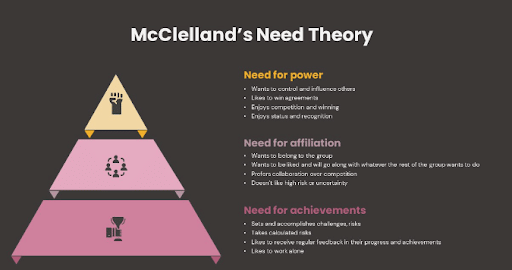
Become a Project Management Professional
- 6% Growth In Jobs Of Project Management Profiles By 2024
- 22 Million Jobs Estimated For Project Management Professionals By 2027
PMP® Certification Training
- Access to Digital Materials from PMI
- 12 Full-Length Simulation Test Papers (180 Questions Each)
Post Graduate Program in Project Management
- Receive Post Graduate Program Certificate and Alumni Association Membership from UMass Amherst
- 8X higher live interaction in live online classes by industry experts
Here's what learners are saying regarding our programs:
Katrina Tanchoco
Shell - manila ,.
The interactive sessions make a huge difference as I'm able to ask for further clarifications. The training sessions are more engaging than the self-paced modules, it's easier now that i first decided to take up the online classroom training, and then followed it up with the self-paced learning (online and readings).
PHC Business Manager , Midlands and Lancashire Commissioning Support Unit
I wanted to transition into the Project Management field and wanted the right opportunity to do so. Thus, I took that leap forward and enrolled in this course. My learning experience was fantastic. It suited my learning style.

Incentive Theory
The theory determines that rewards or punishments influence employees' work behavior. Therefore, these are the primary motivators for individuals performing certain tasks and achieving specific results. For instance,
- Bonus: It refers to the reward that is given to the employees for their exceptional performance.
- Opportunity: It is a type of incentive given to individuals through paid training or continuing education to enhance their knowledge and build their skills.
- Promotion: Providing a higher position or salary can make employees feel their importance and growth.
- Paid off: Providing compensation for taking leave as additional holidays on emergency needs or planned trips can make employees feel satisfied.
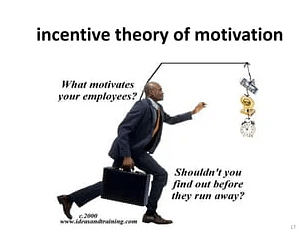
Herzberg's Two-Factor Theory
The theory states that two factors influence satisfaction or dissatisfaction:
- Hygiene Factors: Satisfaction can be influenced by factors like professional relations, policies, working environment, attitude of the supervisor. If these factors are fine, they can motivate employees and vice versa.
- Motivators Factors: Motivating factors, including recognition, personal growth, achievements, career and responsibilities, are crucial for employees. Acknowledging these enhances job satisfaction.
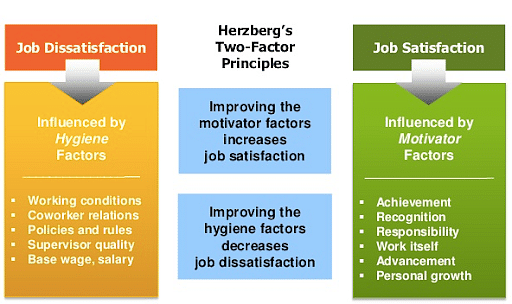
Vroom's Expectancy Theory
The theory states that expectations for the future can have a major impact on an individual’s motivation. It means that conscious choices from the options given can boost pleasure and decrease pain. The factors that influence motivation are:
- Expectancy: It implies that Increased efforts bring success. It means if you work hard, you will get better outcomes.
- Instrumentality: Getting incentives or rewards if you meet performance expectations.
- Valence: It refers to how an employee gives importance to the expected results.
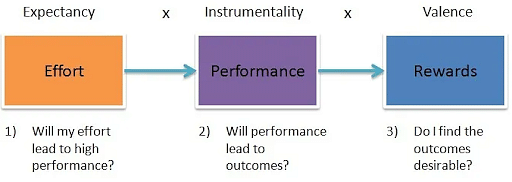
McGregor’s Theory X And Theory Y
McGregor introduced Mcgregor’s theory in his book named ‘The Human Side of Enterprise.’ In the book, he stated two styles of management, i.e.,
1. Theory X:
The theory incorporates micromanaging individuals who have low motivation, are incapable of performing well, dislike their work, avoid work and responsibility and so on. Micromanagement gets the task done appropriately by using an authoritarian style of management.
2. Theory Y:
The theory states that managers can use a decentralized and participative management approach for people who are enthusiastic towards their work, take responsibility for their work or do not need to be supervised to get the task done appropriately.
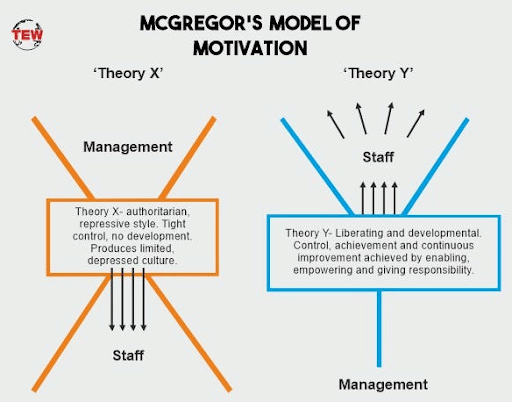
Alderfer’s Erg Theory
The theory liquidized Maslow’s five hierarchy of needs into three categories, i.e., existence, growth and relatedness, along with physiological and materialistic desires (such as affection, clothing, food, water, etc.). It focuses on the following:
- Existence: It involves the basic needs for living, like food and shelter.
- Growth: It determines the intrinsic need for personal development aligned with self-esteem, achievement, and confidence. It requires problem-solving skills, creativity and morality.
- Relatedness: It involves interpersonal relationships, such as social interactions, terms with family members, belongings or love-related needs.
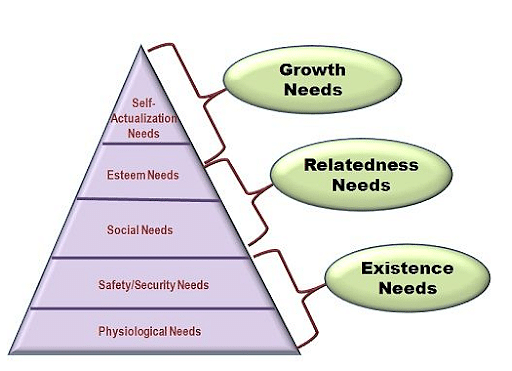
Theories of motivation aid management teams in bringing out the best ways to achieve organizational goals and work toward the desired outcomes. If we apply the theories of motivation successfully, it helps to bring positiveness, support, and inspire the employees efficiently, leading to the growth of individuals, teams and the entire organization.
Want to build experts in your teams but do not know how to apply the theories? Join the PMP Certification Training Course to be a successful project management professional. The training involves practice sessions with an updated PMP examination preparation. Join now to upskill!
1. What are the theories of motivation?
Theories of motivation help understand the factors that motivate individuals to perform efficiently toward their specific goals. It helps management to influence individuals to achieve the result effectively.
2. Who is the father of motivation theory?
An American psychologist, Abraham Maslow, is popularly known as the father of motivation theory.
3. What is Maslow's motivation theory?
Maslow’s motivation theory determines the five fundamental needs of individuals. It incorporates physiological, safety, love and belongingness (social need), esteem and self-actualization needs. Individuals cannot switch to their complex high-level needs before fulfilling these fundamental needs.
Our Project Management Courses Duration And Fees
Project Management Courses typically range from a few weeks to several months, with fees varying based on program and institution.
Learn from Industry Experts with free Masterclasses
Project management.
How to Successfully Ace the PMP Exam on Your First Attempt in 2024
Career Masterclass: How to Successfully Ace the PMP Exam on Your First Attempt in 2024
Career Fast-track
Panel Discussion: The Startup Career Strategy - The Highs and Lows
Recommended Reads
An Introduction to Project Management: A Beginner’s Guide
The Basic Principles of Project Management
What is Agile Project Management?
Project Management Interview Guide
PMP Study: 3 Types of Contracts in Project Management
What Is Project Management?
Get Affiliated Certifications with Live Class programs
- PMP, PMI, PMBOK, CAPM, PgMP, PfMP, ACP, PBA, RMP, SP, and OPM3 are registered marks of the Project Management Institute, Inc.
Home — Essay Samples — Business — Leadership and Management — Three Perspectives Of Motivation
Three Perspectives of Motivation
- Categories: Leadership and Management Organizational Behavior
About this sample

Words: 693 |
Published: Mar 13, 2024
Words: 693 | Pages: 2 | 4 min read
Table of contents
The biological perspective, the cognitive perspective, the sociocultural perspective.
- Bandura, A. (1986). Social foundations of thought and action: A social cognitive theory. Prentice-Hall, Inc.
- Berridge, K. C. (2007). The debate over dopamine's role in reward: the case for incentive salience. Psychopharmacology, 191(3), 391-431.
- Deci, E. L., & Ryan, R. M. (2000). The" what" and" why" of goal pursuits: Human needs and the self-determination of behavior. Psychological Inquiry, 11(4), 227-268.
- Locke, E. A., & Latham, G. P. (2002). Building a practically useful theory of goal setting and task motivation: A 35-year odyssey. American Psychologist, 57(9), 705-717.
- Markus, H. R., & Kitayama, S. (1991). Culture and the self: Implications for cognition, emotion, and motivation. Psychological Review, 98(2), 224-253.
- Wise, R. A. (2004). Dopamine, learning and motivation. Nature Reviews Neuroscience, 5(6), 483-494.

Cite this Essay
Let us write you an essay from scratch
- 450+ experts on 30 subjects ready to help
- Custom essay delivered in as few as 3 hours
Get high-quality help

Dr Jacklynne
Verified writer
- Expert in: Business

+ 120 experts online
By clicking “Check Writers’ Offers”, you agree to our terms of service and privacy policy . We’ll occasionally send you promo and account related email
No need to pay just yet!
Related Essays
1 pages / 2105 words
2 pages / 804 words
2 pages / 694 words
2 pages / 785 words
Remember! This is just a sample.
You can get your custom paper by one of our expert writers.
121 writers online
Still can’t find what you need?
Browse our vast selection of original essay samples, each expertly formatted and styled
Related Essays on Leadership and Management
Bass, B. M., & Avolio, B. J. (1990). Transformational leadership development: Manual for the multifactor leadership questionnaire. Palo Alto, CA: Consulting Psychologists Press.Ferrie, J. E., Shipley, M. J., Marmot, M. G., [...]
In today's fast-paced and competitive world, the ability to take disciplined initiative has become increasingly crucial for success in various aspects of life. Disciplined initiative can be defined as the willingness and ability [...]
The Clayton Johnson case study is a fascinating and complex examination of the challenges and opportunities that arise in the world of business and leadership. This essay will provide a thorough analysis of the case study, [...]
"Self-critique is an essential component of personal and professional growth. It involves reflecting on one's own performance, identifying areas for improvement, and developing strategies to enhance skills and abilities. In the [...]
Management is the administration of a company, a not-for-profit organization, or government body. Personnel management has been formulated over the years and includes staff motivation as a part of the science. Therefore, [...]
Ethics are essential in the Airline business because they are the framework that guides individuals in the process of making business decisions. They usually cover three features, i. e. an application of one's professional [...]
Related Topics
By clicking “Send”, you agree to our Terms of service and Privacy statement . We will occasionally send you account related emails.
Where do you want us to send this sample?
By clicking “Continue”, you agree to our terms of service and privacy policy.
Be careful. This essay is not unique
This essay was donated by a student and is likely to have been used and submitted before
Download this Sample
Free samples may contain mistakes and not unique parts
Sorry, we could not paraphrase this essay. Our professional writers can rewrite it and get you a unique paper.
Please check your inbox.
We can write you a custom essay that will follow your exact instructions and meet the deadlines. Let's fix your grades together!
Get Your Personalized Essay in 3 Hours or Less!
We use cookies to personalyze your web-site experience. By continuing we’ll assume you board with our cookie policy .
- Instructions Followed To The Letter
- Deadlines Met At Every Stage
- Unique And Plagiarism Free
What is Motivation? A Psychologist Explains

The simplest definition of motivation boils down to wanting (Baumeister, 2016). We want a change in behavior, thoughts, feelings, self-concept, environment, and relationships.
People often say that motivation doesn’t last. Well, neither does bathing – that’s why we recommend it daily.
This article shows what motivation is, both in real life and in how psychology observes and studies motivation. It includes an explanation of the process by analyzing real-world motivational problems like procrastination and avoidance.
Before you continue, we thought you might like to download our three Goal Achievement Exercises for free . These detailed, science-based exercises will help you or your clients create actionable goals and master techniques to create lasting behavior change.
This Article Contains:
What is motivation, motivation definition in psychology, motivation model, motivation process, motivation cycle, recommended books on motivation, a take-home message.
Motivation is an internal process. Whether we define it as a drive or a need, motivation is a condition inside us that desires a change, either in the self or the environment. When we tap into this well of energy, motivation endows the person with the drive and direction needed to engage with the environment in an adaptive, open-ended, and problem-solving sort of way (Reeve, 2015).
The essence of motivation is energized and persistent goal-directed behavior. When we are motivated, we move and take action.
Motivation is influenced by the satisfaction of needs that are either necessary for sustaining life or essential for wellbeing and growth. Physiological needs for food, water, and sex (yes sex) serve the organism to maintain life and also provide satisfaction from doing so.
Psychological needs for autonomy, mastery, and belonging direct our behavior in much the same way. As do the needs for achievement, power, closure, meaning, and self-esteem. Some of these needs will become motives as will all the intrinsic activities we engage in.
Our environment and social context will play a significant role in terms of extrinsic motivation. We will also be motivated by goals, values, and desires to experience specific emotions associated with certain end-states (Reeve, 2015).
The best way to explain motivation is to show what it looks like in everyday life. Here is an example of possible motivational reasons a person could have to engage in exercise.
For a more in-depth discussion of the many mechanisms of motivation, see our article on Motivation and What Really Drives Human Behavior .

Download 3 Free Goals Exercises (PDF)
These detailed, science-based exercises will help you or your clients create actionable goals and master techniques for lasting behavior change.
Download 3 Free Goals Pack (PDF)
By filling out your name and email address below.
- Email Address *
- Your Expertise * Your expertise Therapy Coaching Education Counseling Business Healthcare Other
- Email This field is for validation purposes and should be left unchanged.
The study of motivation in psychology revolves around providing the best possible answers to two fundamental questions: what causes behavior, and why does behavior vary in its intensity?
Motivational science is a behavioral science that seeks to construct theories about what constitutes human motivation and how motivational processes work.
Motivation, when seen in the real world, and when measured by science , becomes visible and detectable through behavior, level of engagement, neural activation, and psychophysiology. Some would also include self-report in this list, but studies show that self-reports have proven to be highly unreliable sources of information (Reeve, 2015).
So how does motivation behave? With presence, intensity, and quality. Motivation is visible through gestures and facial expressions, intense effort, immediacy (or as psychologists like to call it short latency).
The presence of motivation can also be inferred from the levels of persistence and decisiveness in choosing one goal over another, which taken together make for a high probability of occurrence (Atkinson & Birch, 1970; 1978; Bolles, 1975; Ekman & Friesen, 1975).
Motivation can also be inferred from the level of engagement.
For example, in a coaching scenario or a motivational interview, a competent practitioner will enthusiastically and generously contribute to the flow of conversation (agentic engagement), express interest and enjoyment (emotional engagement), process deeply and pay attention (cognitive engagement), and persist in these efforts as if time and the outside world didn’t exist (behavioral engagement). And yes, for many of us, we don’t have those kinds of conversations often.
Psychophysiology
There are five psychophysiological expressions of motivation:
Brain Activations
Just like changes in behavior, engagement, and psychophysiology, brain activations mark the rise and fall and maintenance of motivational states. A different pattern of neural activity is present with each motivation and emotion. For example, the hypothalamus is active when we are thirsty, and when we feel disgusted, there is a rise in insular activity.
Researchers use sophisticated equipment like electroencephalography (EEG) and functional magnetic resonance imaging (fMRI) to observe, detect, monitor, and measure brain-based neural activity.
See our blog post on Motivation Science for more information on the neuroscience of motivation.
Putting all this together to answer the perennial question of what motivation is, but most importantly what it does, we define motivation as rising and falling of needs, cognition, and emotions expressed through patterns of behavior, levels of engagement and neural and psychophysiological activity directed toward realizing essential life outcomes. Video
How to motivate yourself to change your behavior – Tali Sharot
In a nutshell, motives are internal experiences in the form of needs, cognitions, and emotions and are the direct and proximal causes of motivated action. Social contexts and external events act as antecedents to motives that cause or trigger motivational states. Our motives express themselves through behavior, engagement, psychophysiology, brain activations, and self-report.
The model below illustrates the framework for how motivational psychologists study the process of motivation and its elements and try to find the answer to the questions about what causes motivation. It also shows why the study of motivation is so relevant to people’s lives and how motivation contributes positively to significant life outcomes like achievement, performance, and wellbeing, to name a few (Reeve, 2015).
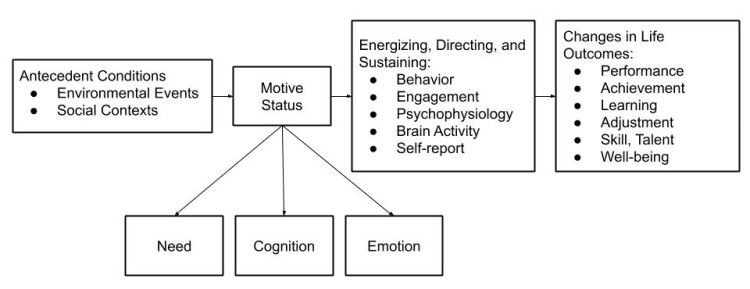
Our motivation, when it originates from internal motives, as categorized into needs, cognitions, and emotions, is often experienced as more immediate and potent than extrinsic motivation.
Since we don’t exist in a vacuum, however, these inner experiences cannot take place without some degree of the external influence, be it in the form of consequences, incentives, or other forms of pressure arising out of the social context of our environment.
Our physiological and psychological needs drive us, our cognitions direct us, and emotions land intensity and energy to our pursuits. When the combination of antecedent conditions and the internal motives align, they create a ripe environment for engagement, which propels the action behavior.
When these behaviors, in turn, create more positive motivational and emotional states, they reinforce the behavior through a positive feedback loop and increase the likelihood of repetition (Reeve, 2015).
The greatest thief this world has ever produced is procrastination, and he is still at large.
Josh Billings
The self-concordance model of goal setting differentiates between four types of motivation (Sheldon & Elliot, 1999).
- External motivation Goals are heavily guided by external circumstances and would not occur without some kind of reward or to prevent a negative outcome.
- Introjected motivation Goals are characterized by self-image or ego-based motivation, reflecting the need to keep a certain self-image alive.
- Identified motivation The actions needed to accomplish the goal are perceived as personally important and meaningful, and personal values are the main drivers of goal pursuit.
- Intrinsic motivation When a behavior is guided by intrinsic motivation, the individual strives for this goal because of the enjoyment or stimulation that this goal provides. While there may be many good reasons for pursuing the goal, the primary reason is simply the interest in the experience of goal pursuit itself.
Goals guided by either identified or intrinsic motivation can be considered self-concordant. Self-concordant goals are associated with higher levels of wellbeing, enhanced positive mood, and higher life satisfaction levels than non-self-concordant goals.

Consider a motivational problem like procrastination or avoidance
Our needs, cognitions, emotions, environments, and relationships can play a crucial role in procrastination or avoidance.
All needs are born either out of deficiency or need for growth. Physiological needs are a particularly strong force in determining behavior. Our bodies will signal our brain if our wellbeing is threatened, and this can lead to avoidance and procrastination when we are suffering from hunger, thirst, or lack of sleep, for example.
Psychological needs are also significant drivers of motives as they represent inborn needs for the development of a sense of autonomy, competence, and relatedness. When we try to force ourselves to do something that contradicts those needs, these innate forces can be tough to overcome.
The conflict between chosen behavior and the need for satisfaction of psychological needs like autonomy can create dissonance, which can lead to avoidance or procrastination. While the fulfillment of physiological needs is about preserving wellbeing, satisfying psychological needs is about thriving and growing as a person (Reeve, 2015).
When we are no longer able to change a situation, we are challenged to change ourselves.
Viktor E. Frankl
There are also implicit needs which are acquired from our environment through socioemotional development. They vary from person to person as our experiences vary, and unlike inborn psychological needs, implicit motives are acquired.
Implicit here means unconscious. These needs occur without conscious awareness and are trait-like and enduring. Implicit needs motivate us toward the pursuit and attainment of specific social incentives (Schultheiss & Brunstein, 2010).
An implicit motive is a psychological need that arises from situational cues that cause emotional reactions, which then predict, guide, and explain people’s behavior and lifestyle. They can be inferred from the person’s characteristic thoughts, emotions, and behaviors. What a person “needs” within an implicit motive is to experience a particular pattern of affect or emotion.
For example, if we have little or no need for achievement, we may experience negative affect, such as anxiety, shame, and embarrassment while engaging in that challenging task and will avoid or procrastinate as a result. Implicit motives predict our behavior far more accurately than do explicit motives, which are basically what we tell others about what motives us (McClelland, Koestner, & Weinberger, 1989).
Our cognitions can also influence our tendency to avoid or procrastinate. Cognitions are mental constructs like goals, mindset, expectations, beliefs, and self-concept, to name a few that influence our motivation. If we have conflicting goals, for example, we may be more likely to avoid or procrastinate.
Change the way you look at things and the things you look at change.
Wayne W. Dyer
Emotions, although closely linked to cognitions and psychological needs, in and of themselves can motivate or demotivate. They can signal the importance of particular behavior. We may feel joy or pride at the possibility of goal attainment through engagement in particular behavior, or we can be afraid of failure and choose to avoid or procrastinate.
Our environment can also be either ideal and supportive or an obstacle to staying motivated and achieving our goals (Reeve, 2015). It can be full of distractions or lack optimal conditions that allow for sustained motivation.
Finally, our relationships can be supportive and empowering when it comes to change. This can be explained through a concept like the Michelangelo phenomenon, where our relationships support our potential. They can also be demotivating as in the Blueberry phenomenon, where the relationship brings out the worst in us and can contribute to procrastination and avoidance.
Motivation is a dynamic process, and our motives vary over time. Raising and falling as circumstances change, and as time passes, motives contribute to the ongoing stream of behavior. To further complicate matters, we are driven by a multitude of different motives at any one point in time.
One motive, usually the one most situationally appropriate, will be strongest and dominate our attention while other motives will be subordinate and lie relatively dormant. Although typically the strongest motive will have the most considerable influence on our behavior, as circumstances change, each subordinate motive can become dominant.
The below example shows how a student’s motivation to read varies over time in strength, starting relatively strong then weakening when compared to the need to hang out with friends or to eat a snack (Reeve, 2015).
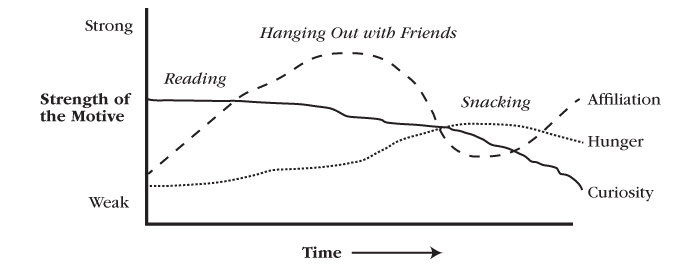
The awareness of how motivation varies over time is particularly important when it comes to goal setting.
When we differentiate the motivational and the performance-based advantages versus disadvantages for those who adopt a short-term goal, as in eating less than 2000 calories today, versus performers who adopt a long-term goal, as in losing 20 pounds this year, we must consider the type of activity they are engaging in before making recommendations.
Short term goals work better for uninteresting activities as they boost commitment by providing feedback on progress more often, which further reinforces the effort to persist (Reeve, 2015).
Motivation to perform routine or boring activities can be improved; however, by providing clarity of goals and choice in how to perform a task. Clarity and choice can fuel a sense of mastery and autonomy, and both, in combination, can increase overall motivation as they satisfy basic psychological needs.
When it comes to interesting tasks, or as Mihaly Csíkszentmihályi (1990) calls them autotelic activities, long-term goals work better as they often provide for greater flexibility and more autonomy in how to pursue them. Short terms milestones can feel intrusive for interesting activities. Autotelic activities are already engaging, and we are often intrinsically motivated to perform them because they produce enjoyment. But most importantly, we are motivated to pursue them in the absence of external rewards or incentives.
′Autotelic′ is a word composed of two Greek roots: auto (self), and telos (goal). An autotelic activity is one we do for its own sake because to experience it is the main goal.
Mihaly Csíkszentmihályi
We also need to keep in mind that motivation to act on the goals is often higher when the goal is based in the near future, while far off goals do not create the tension of immediacy that would motivate us to act right away (Reeve, 2015).
To learn more about the types of motivation that exist, see our article on Motivation and What Really Drives Human Behavior .
You can also find many different approaches to increase motivation in the below list of self-help books published on the subject. Some are more philosophical, others biographical, and a few present recent research in motivation psychology.

17 Tools To Increase Motivation and Goal Achievement
These 17 Motivation & Goal Achievement Exercises [PDF] contain all you need to help others set meaningful goals, increase self-drive, and experience greater accomplishment and life satisfaction.
Created by Experts. 100% Science-based.
There is a wide array of books on motivation, covering different aspects and genres. Making a selection of the top ten was just not possible, so here is a list of 16 excellent books on motivation.
1. Finite and Infinite Games

The goal is to keep playing with boundaries.
Available on Amazon .
2. Talent is Overrated: What Really Separates World-Class Performers from Everyone Else

Masters practice, practice, practice. One must deliberately engage in mentally demanding and repetitive activity to become an expert.
3. Flow: The Psychology of Optimal Experience

Flow as motivation.
4. Why We Do What We Do: Understanding Self-Motivation
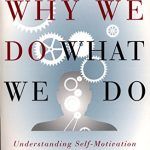
Motivation is something people do, not something that is done to them.
5. Mindset: The New Psychology of Success

Keep finding opportunities to improve.
6. Then We Came to the End

Joshua Ferris shares a humoristic yet emotionally true reflection about survival in life’s strangest environment – the office.
7. Good Work

Focusing on genetics and journalism, this eagerly awaited book investigate the exhibition of humane creativity, where performance is coupled with social responsibility.
Available on Amazon .
8. Outliers: The Story of Success
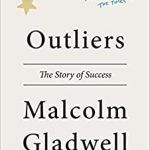
Creative work is more satisfying, but success is influenced by many factors.
9. Team of Rivals: The Political Genius of Abraham Lincoln

Winner of the prestigious Lincoln Prize and the inspiration for the Oscar Award winning–film Lincoln, starring Daniel Day-Lewis, directed by Steven Spielberg, and written by Tony Kushner. Need we say more?
10. The Amateurs

Pulitzer Prize-winning writing skills combined with sport journalism results in a highly acclaimed book.
11. Punished by Rewards

Rewards motivate us only to get more rewards.
12. Once a Runner

Always better than himself.
13. The War of Art: Break Through the Blocks & Win Your Inner Creative Battles

We are not ready for freedom. The paradox is that we are free only to the extent of our self-mastery.
14. Maverick: The Success Story Behind the World’s Most Unusual Workplace

How to be self-sufficient.
15. The Fifth Discipline: The Art & Practice of The Learning Organizations
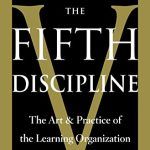
In learning organizations, life is a work of art.
16. Good to Great: Why Some Companies Make the Leap and Others Don’t

A study by Jim Collins and his research team over five years, revealed much-needed insight into management strategies and more.
It seems it isn’t that simple to find the motivation to do this thing that is so important to us. We must consider if it competes with other motives, and perhaps take stock of our values to make sure that this not the case. Often we may have to intervene in how our motivation is influenced by external incentives present in our environment or social context to make sure that we match those to high internal motives.
Motivation science tells us that if we want to be successful in motivating our own or other people’s behavior, high internal motives should be matched with high external motivations. Finally, we will often want to sustain the motivation over some time and may have to create a regiment of reminders, repetitions, and rituals — more on that in our article on motivation tools .
How do you hack motivation? What helps you stay committed?
Share your experience in the comments section.
We hope you enjoyed reading this article. Don’t forget to download our three Goal Achievement Exercises for free .
- Atkinson, J. W., & Birch, D. (1970). On the dynamics of action. Nederlands Tijdschrift voor de Psychologie en haar Grensgebieden, 25 (2), 83-94.
- Atkinson, J. W., & Birch, D. (1978). An introduction to motivation (2nd ed.). Van Nostrand.
- Baumeister, R. F. (2016). Toward a general theory of motivation: Problems, challenges, opportunities, and the big picture. Motivation and Emotion, 40 (1), 1-10.
- Bolles, R. C. (1975). Learning theory . Holt, Rinehart & Winston.
- Csíkszentmihályi, M. (1990). Flow: The psychology of optimal experience. HaperCollins.
- Ekman, P., & Friesen, W. V. (1975). Unmasking the face: A guide to recognizing emotions from facial expressions. Englewood Cliffs, NJ: Prentice-Hall.
- McClelland, D. C., Koestner, R., & Weinberger, J. (1989). How do self-attributed and implicit motives differ? Psychological Review, 96 (4), 690-702.
- Reeve, J. (2015). Understanding motivation and emotion (6th ed.). Hoboken, NJ: Wiley.
- Schultheiss, O., Brunstein, J., & Brunstein, J. C. (2010). Implicit motives . Oxford University Press.
- Sheldon, K. M., & Elliot, A. J. (1999). Goal striving, need satisfaction, and longitudinal well-being: the self-concordance model. Journal of Personality and Social Psychology, 76(3) , 482.
Share this article:
Article feedback
What our readers think.
Beautiful article….Thank you very much it make me to understand perfectly
Thank you for an interesting read! A great view on a topic I am greatly interested in 🙂
I am looking for the Wayne W. Dyer reference – is there any pointers for this?
Many thanks.
Glad you enjoyed the post! I believe this was a spoken quote, not from a written source (see here ).
– Nicole | Community Manager
First, I appreciate your blog; I have read your article carefully, Your content is very valuable to me. I hope people like this blog too. I hope you will gain more experience with your knowledge; That’s why people get more information.
It’s THAN not THEN.
Motivation Process Our motivation, when it originates from internal motives, as categorized into needs, cognitions, and emotions, is often experienced as more immediate and potent —then —-extrinsic motivation
Oops! Thank you for bringing this to our attention — I’ve just corrected it 🙂
Amazing article, I came across this article for a paper I am writing in college and found it extremely useful. Additionally I own a part time dog training business and find that motivation is a hugely underappreciated concept within dog training. I base much of my training on motivation and find this article to be extremely beneficial in understanding motivation as it applies to both humans and animals as well as the behavior that come from it. Lastly I really appreciated the recommended books at the end, I just downloaded a few of them off of audible and will continue my studies on motivation.
Let us know your thoughts Cancel reply
Your email address will not be published.
Save my name, email, and website in this browser for the next time I comment.
Related articles

Victor Vroom’s Expectancy Theory of Motivation
Motivation is vital to beginning and maintaining healthy behavior in the workplace, education, and beyond, and it drives us toward our desired outcomes (Zajda, 2023). [...]

SMART Goals, HARD Goals, PACT, or OKRs: What Works?
Goal setting is vital in business, education, and performance environments such as sports, yet it is also a key component of many coaching and counseling [...]

How to Assess and Improve Readiness for Change
Clients seeking professional help from a counselor or therapist are often aware they need to change yet may not be ready to begin their journey. [...]
Read other articles by their category
- Body & Brain (48)
- Coaching & Application (57)
- Compassion (26)
- Counseling (51)
- Emotional Intelligence (24)
- Gratitude (18)
- Grief & Bereavement (21)
- Happiness & SWB (40)
- Meaning & Values (26)
- Meditation (20)
- Mindfulness (45)
- Motivation & Goals (45)
- Optimism & Mindset (34)
- Positive CBT (28)
- Positive Communication (20)
- Positive Education (47)
- Positive Emotions (32)
- Positive Leadership (17)
- Positive Parenting (2)
- Positive Psychology (33)
- Positive Workplace (37)
- Productivity (16)
- Relationships (47)
- Resilience & Coping (35)
- Self Awareness (21)
- Self Esteem (37)
- Strengths & Virtues (31)
- Stress & Burnout Prevention (34)
- Theory & Books (46)
- Therapy Exercises (37)
- Types of Therapy (64)

3 Goal Achievement Exercises Pack
Motivation and Leadership Theories Essay
Introduction, motivated workforce, works cited.
Leadership is a concept that has been applied in organizations to encourage people to achieve goals. Leaders motivate the followers to achieve the goals of an organization. Therefore, leadership and motivation should be applied together to achieve the intended objectives (Certo, p. 149).
Transformational theory
Leaders apply transformational strategies to change the old systems and install new systems in an organization. In an organization, this can be achieved by collaborating with all stakeholders (Certo, p. 152). From the case study, Jonathan is seen as a transformational leader who is attentive to his workers.
Jonathan is focused on the performance of his group by allowing flexibility in the job environment. He assigns his workers different duties each weak, so the workers do not get bored by doing the same task each week. On the other hand, Dan is supervisor who is adamant to allow his worker change work strategies. Hence, Alex complains about doing the same task each weak. Dan does not believe that the best way of learning is doing the same thing over and over again. Alex condemns the way Dan handles the workers.
Participative theory
Participative theory suggests that ideal leadership style requires the input of others. This helps the member of the group to feel relevant in that organization and engaged in decision making process (Certo, p. 123). In the case study, Jonathan applies this theory by encouraging his employees to notify him when the items are running low. He also empowered them to obtain items from the vendors.
Motivation theories
For employees to perform their duties to the expectations of an organization, they need to be motivated. Several people have suggested varied theories to find out the workers can be greatly motivated.
Contribution theory
The theory was developed by Rensis Likert. According to Likert organizations can be broken down into primitive authoritarian, benevolent authoritarian, consultative and participative systems of management. He suggests an organization that embraces this approach is more likely to have motivated workers than organizations that adopt other system. In the case contest, Dan is flexible enough to allow his workers do their work on the own receives feedback from them regarding the job.
He discusses job issues with Stephanie and lets her actively participate in determining how the work is to be done. Despite the fact that the work seems difficult Stephanie is motivated because she new assignments as chance to learn new things. On contrast, Dan doesn’t discuss work matters with his employees to find out how better the work can be done. This has left Alex disgruntled and disappointed with his leadership style.
Needs Hierarchy theory
This theory postulates that employees are not only motivated by rewards in form of salaries and other bonuses but by also by satisfying employees’ various needs. Such needs are physiological, security, social, esteem and self-actualization. Any organization that tend to focus on satisfying employee needs is bound to have
In the case study Jonathan understands this and tries appreciating the work done by his employees. He allows his employees to socially and achieves self-actualization about their work performance. Dan on the other hand limits employee’s freedom of socialization by not letting them have a sense of security and association.
To motivate workers, managers should understand that special attention needs to be paid to worker needs and expectations from organization. They should strive to achieve good working relationship with the workers for proper motivation and performance.
Certo, Samuel. Modern Management: International Version . Harlow: Pearson Education Ltd, 2011. Print.
- Chicago (A-D)
- Chicago (N-B)
IvyPanda. (2023, December 4). Motivation and Leadership Theories. https://ivypanda.com/essays/motivation-and-leadership-theories-essay/
"Motivation and Leadership Theories." IvyPanda , 4 Dec. 2023, ivypanda.com/essays/motivation-and-leadership-theories-essay/.
IvyPanda . (2023) 'Motivation and Leadership Theories'. 4 December.
IvyPanda . 2023. "Motivation and Leadership Theories." December 4, 2023. https://ivypanda.com/essays/motivation-and-leadership-theories-essay/.
1. IvyPanda . "Motivation and Leadership Theories." December 4, 2023. https://ivypanda.com/essays/motivation-and-leadership-theories-essay/.
Bibliography
IvyPanda . "Motivation and Leadership Theories." December 4, 2023. https://ivypanda.com/essays/motivation-and-leadership-theories-essay/.
- Equity Concept: Motivation and Features in Leadership
- Leadership Theories and Motivation Issues
- The Main Ideas of Stephanie Syjuco’s Art
- Family Model: Stephanie Coontz’s “What We Really Miss About the 1950s”
- The Reasons and Extent of Popularity of the Children’s Book “Twilight” by Stephanie Meyer
- Self-Actualization: Interpersonal Communication
- Social Psychologists Jonathan Haidt and Dan Ariely
- Small Business Marketing Plan: Dan’s Auto and Trucks Repair Company
- Likert Questionnaires in Education
- Dame Stephanie Shirley's Psychological Adjustments
- Information Security at the PWC
- Significance of Organizational Behavior
- A Discussion of the Strategic Management Practice in Facebook
- Jordan Events Company: Management Skills and Entrepreneurship
- Wrigley’s Innovation in China’s Confectionary Market

IMAGES
VIDEO
COMMENTS
This paper explores theories of motivation, including instinct theory, arousal theory, incentive theory, intrinsic theory, extrinsic theory, the ARCS model, self-determination theory, expectancy-value theory, and goal-orientation theory. Each theory is described in detail, along with its key concepts, assumptions, and implications for behavior.
As such, expectancy theory states that motivating people should come down to three things ("Expectency Theory" n.d.). First, motivation is a factor of effort ("Expectency Theory" n.d.). In order to motivate others, employers should encourage the belief that more effort equals better performance. Second, employers should encourage the ...
Motivation Theory in marketing. When applying motivation theories in marketing, few changes are necessary. As explained by O'Neil and Drillings (1994) "different employees in different departments will be motivated by different incentives" (p.233). In the marketing of merchandise, high levels of motivation are required from the staff.
This theory focuses on how interpretations of the reasons for success or failure in an event affect motivation for future events. Weiner identified that the most frequent achievement attributions relate to ability, effort, task difficulty, and luck. These attributions can be classified in three causal dimensions.
Theories on Motivation. Motivation is a way of creating high level of enthusiasm to reach organizational goals, and this. situation is a ccommodated by satisfying some individual need. Basically ...
Other process motivation theories combine aspects of reinforcement theory with other theories, sometimes from adjacent fields, to shine a light on what drives human behavior. Adams' equity theory of motivation. ... if I were to write an essay on Motivation. Reply. Sunny on July 20, 2022 at 02:14
It is the driving force behind human actions. Motivation is the process that initiates, guides, and maintains goal-oriented behaviors. For instance, motivation is what helps you lose extra weight, or pushes you to get that promotion at work. In short, motivation causes you to act in a way that gets you closer to your goals.
The first set of theories focuses on the innateness of motivation. These theories emphasize instinctual or inborn needs and drives that influence our behavior. The second set of theories proposes cognition as the source of motivation. Individual motivation is influenced by thoughts, beliefs, and values.
Some of the common hypotheses used to explain motivation include the drive or needs theory and arousal theory. According to the drive theory of motivation, human beings have needs that must be met in order to have the required level motivation (Beck 100). There are five levels of human needs, namely psychological, safety, social, admiration ...
Describe basic theories of motivation, including concepts such as instincts, drive reduction, and self-efficacy. William James (1842-1910) was an important contributor to early research into motivation, and he is often referred to as the father of psychology in the United States. James theorized that behavior was driven by a number of ...
Motivation, the psychological construct 'invented' to describe the mechanism by which individuals and groups choose particular behaviour and persist with it, has a history going back millennia in all cultures. Ancient Greek, Roman, Egyptian, Indian, Chinese, and Indigenous cultures from all continents developed rubrics about positively ...
Motivation is often taken for granted in psychology, perhaps because it is hidden beneath the actions we take. The relative visibility of our actions and the relative invisibility of their motivational underpinnings may explain why some researchers—such as many who study cognition, intelligence, or personality—do not see their phenomena as arising from and importantly influenced by motivation.
The Motivational Theory will be shown to explain how emotions motivate better than Cognitivism and Perceptualism, and to offer solutions to two outstanding problems in the philosophy of emotions: explaining the intentionality of emotions and explaining how emotions differ from one another.
intrinsic behavior-helping theorists understand the way humans respond to situations. In this chapter we will discuss on four foundational theories of motivation which include: Maslow's Hierarchy of Needs, Herzberg's Two-Factor Theory, McClelland's Three Needs. Theory, and McGregor's Theory X, Theory Y.
Cognitive evaluation theory: This theory suggests that there are actually two types of motivation; intrinsic and extrinsic which correspond to two types of motivators: Intrinsic motivators; that come from actual performance of the task e.g achievement, responsibility and competence.
Theories of motivation aid management teams in bringing out the best ways to achieve organizational goals and work toward the desired outcomes. If we apply the theories of motivation successfully, it helps to bring positiveness, support, and inspire the employees efficiently, leading to the growth of individuals, teams and the entire organization.
In this essay, we will explore three perspectives of motivation: the biological perspective, the cognitive perspective, and the sociocultural perspective. ... Additionally, cognitive theories of motivation highlight the importance of goal-setting, self-regulation, and intrinsic motivation in driving behavior (Locke & Latham, 2002). The ...
In other words, Maslow's theory organizes individual needs from basic to complex. In addition, motivation is determined based upon whether those needs are met. Maslow's hierarchy of needs consists of "the physiological needs, the safety needs, the belongingness or love needs, the esteem needs, and the need for self-actualization ...
A Theory of Human Motivation. A. Maslow. Published 1943. Psychology. 1. The integrated wholeness of the organism must be one of the foundation stones of motivation theory. 2. The hunger drive (or any other physiological drive) was rejected as a centering point or model for a definitive theory of motivation. Any drive that is somatically based ...
The dictionary defines motivation as "the reason why somebody does something or behaves in a particular way" (Oxford Advanced Learner's Dictionary of Current English, 2000, p1128). Many theorists over the years starting from the industrial revolution have analysed what makes workers work harder. This essay will illustrate why there are ...
Review Questions. 1. Why might drive reduction theories be inadequate for explaining motivation? Drive reduction theories are inadequate for explaining motivation for three reasons: A. They don't explain why people sometimes aren't motivated by internal needs.
Whether we define it as a drive or a need, motivation is a condition inside us that desires a change, either in the self or the environment. When we tap into this well of energy, motivation endows the person with the drive and direction needed to engage with the environment in an adaptive, open-ended, and problem-solving sort of way (Reeve, 2015).
In this essay, I aim to highlight and analyse three of the most well-known theories of motivation in relation to social class disparity within the UK workplace, and try to offer solutions to this problem using the three theories of motivation. These three theories are McClelland's Need for Achievement Theory, McGregor's Theory X and Y, and ...
Needs Hierarchy theory. This theory postulates that employees are not only motivated by rewards in form of salaries and other bonuses but by also by satisfying employees' various needs. Such needs are physiological, security, social, esteem and self-actualization. Any organization that tend to focus on satisfying employee needs is bound to have.
With the improvement of Chinas education penetration rate, The average education level of people is rising. The majority of students are satisfied to have finished the required schooling stage and wish to pursue higher education by working toward a bachelors, masters, or doctoral degree. According to psychologys theory of motivation, motivation mostly takes the form of a personal desire or ...